McCarthy vs. Paz: Waltham mayoral election heats up
■ Paz rallies supporters to "turn the chapter" on 19year incumbent Jeanette A. McCarthy.
By MESHULAM UNGAR JUSTICE STAFF WRITER
Speaking to a crowd of a few dozen supporters at a bar in downtown Waltham on Sept. 28, Ward 9 City Councilor Jonathan Paz argued his case for Waltham mayor, marking the beginning of his general election campaign.
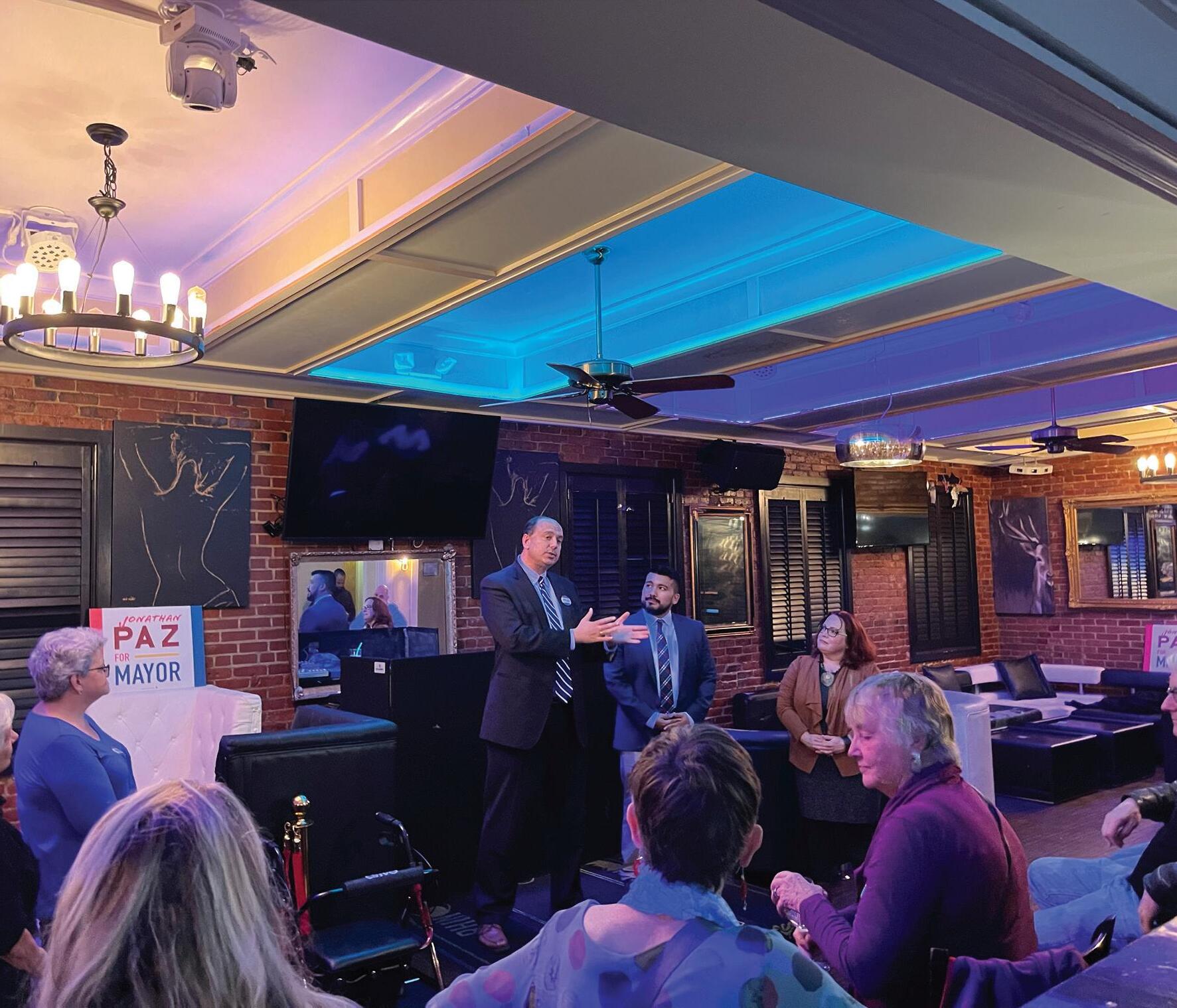
On Sept. 12, Waltham voted in a preliminary election, with Paz and fellow Democrat Jeanette A. McCarthy advancing to the general election on Nov. 7. McCarthy has been mayor of Waltham since 2004 and is running for a record sixth term; she holds an 18% lead based on last month’s results. If elected, Paz will be the first Latino mayor in Waltham.
At the opening event, Paz framed the race as his “rainbow coalition,” consisting of Waltham’s cultural and ethnic diversity, versus McCarthy’s “old Waltham.” Paz declared that his “campaign … will make an upset of the status quo possible,”
and contrasted his “inclusive, transparent, [and] collaborat[ive]” style to McCarthy’s “way of keeping the insiders inside, and leaving the public shut out.”
In a Waltham Community Access Channel candidate forum hosted in August 2023, McCarthy laid out her key priorities: addressing the Eversource power surges, Massachusetts Water Resources Authority work around Lexington Street, a growing rat infestation in the city, and a new high school opening planned for August 2024. McCarthy made her appeal for reelection without mentioning Paz in her nearly 13-minute remarks. Instead, she highlighted her extensive conversations with local and state officials about putting pressure on Eversource to fix its three power stations in Waltham and the calls she received from local residents on Moody Street regarding trash pick up. McCarthy focused on municipal issues and reiterated that her policy and management experience put her above the normal campaign fray.
McCarthy addressed Paz in a city-wide mailer that criticized his record as a city councilor. In the letter, McCarthy points out that Paz abstained on two votes during a June 15, 2020 Waltham Special City Council meeting over Waltham
Angel Tea
Angel Zhao '25's boba tea shop lights up Moody Street.
 By CAYENN LANDAU
By CAYENN LANDAU
ENVIRONMENTAL ACTIVISM

Brandeis attends march in New York City to protest fossil fuel use
■ Students and faculty connected with other climate activists and joined the demonstration.
By HEDY YANG JUSTICE STAFF WRITER
On Sunday, Sept. 17, about 50
Brandeis students and faculty took to the streets of New York City to demand an end to the expansion of fossil fuels. The March to End
Fossil Fuels, organized by a broad base of NYC grassroots organizations, was the largest climate action since the start of the pandemic; event organizers estimate that 75,000 people were in attendance. The intent of the protest was to place pressure on President Joe Biden ahead of Climate Week NYC and the United Nations 2023 Sustainable Development Goals Summit, which took place in New York City on Sept. 17-24 and Sept. 18-19, respectively. The event organizers called for Biden to ban the usage of fossil fuels and protect communi-
NATIONAL STANDING
Police Department funding, saying that “Mayoral Candidate Paz now says he supports the police … that is not factual.” Paz reiterated this claim during an interview with the Justice on Sept. 28. According to the minutes of that meeting, the City Council had a disagreement over the combined $69,500 of police expenditures, which became a debate over how Waltham should react to the murder of George Floyd and whether cuts should be made to the police budget. The meeting minutes indicate that Paz did not take a strong position on the matter, but did abstain from the vote to withdraw police funding. The final result was 13 against, one for, and one abstain.
The mailer also critiqued Paz’s choice to abstain on the municipal and school budget votes in 2022. It then highlighted Paz’s vote against the municipal budget in 2023 — all city services except schools — pointing to his alleged inconsistency and defunding of essential services if the budget did not pass.
In Paz’s approximately five minute remarks at the WCAC candidate forum in August 2023, he touched on many of the same issues that he addressed at the Sept. 28 event.
ties’ rights to a clean and healthy environment by “stopping oil and gas projects, phasing down drilling, and declaring a climate emergency.”
Prof. Sabine von Mering (WGS)

first proposed the idea of chartering a bus to bring Brandeis students to the march in mid-August. In an email correspondence to the Justice on Sept. 20, Prof. von Mering stated that she had heard about the march through various climate action groups she is a part of, and felt that it was a great opportunity for students to witness and participate in climate action at such a significant scale. “It always recharges my own activist batteries to be in a crowd like this of like-minded people who all feel the urgency about the climate emergency,” she said. “I wanted students to feel that, too.”
From there, the initiative became a collaboration between Prof. von Mering, Prof. Sally Warner (ENVS), and Prof. Charlie Chester (ENVS) to coordinate student inSee PROTEST, 5 ☛
Brandeis's U.S. News and World Report ranking drops 16 spots
■ First-year international students expressed their reaction to the University’s ranking drop.
By MINJUE KIM CONTRIBUTING WRITER
On Sept. 18, the U.S. News and World Report released its annual college ranking which revealed drastic shifts on the previous rankings due to a change in the metrics used to determine the rankings of colleges. As a result, Brandeis University dropped 16 spots on the list from 44 to 60.
In the Sept. 18 email sent to the Brandeis students, faculty, and staff, President Ron Liebowitz elaborated that the change in methodology was not favorable to private institutions like Brandeis. According to Liebowitz, the new methodology reduced the significance of faculty salaries and the weight of the financial resources per student and eliminated metrics that favored private institu-

tions such as class size, which he pointed out as a significant factor of Brandeis' dropped ranking, as well as the number of faculty with a terminal degrees, alumni-donations, and high school standings.
Liebowitz also pointed out that valuing “expected graduation rates” rather than “actual graduation rates” favored large public institutions, yet he expressed his pride in the Brandeis' high graduation rates despite its influence on the ranking.
“When the metrics align with our strategic priorities as a university, we will work to enhance them,” said Jarret Bencks, senior content and marketing communications specialist at Brandeis in a Sept. 20 email to the Justice. “For example, we want the work of faculty to be properly attributed. That is an area of interest that we were working on, before it became more important in the rankings, that we will continue to work on,” he elaborated. “The University is focused on the priorities PresiSee RANKINGS, 5 ☛
New COVID-19 protocol
By River Simard
Devil's Advocate: Filibuster
By MIKEY TERRENZI
By Jack Granahan and Stephen Gaughan Damian Lillard
By Jackson Wu
Justicethe www.thejustice.org Volume LXXVI, Number 3 Waltham, Mass. For tips or info email editor@thejustice.org Make your voice heard! Submit letters to the editor to forum@thejustice.org COPYRIGHT 2023 FREE AT BRANDEIS. Tuesday, October 3, 2023
women
Italy This review is a beautiful ode to the feminists works from the Italian Renaissance.
Strong
in Renaissance
T he I ndependen T S T uden T n ew S paper of B rande IS u n I ver SIT y S I nce 1949
Photo courtesy of CREATIVE COMMONS FEATURES 6
NEWS 3 FORUM 9 SPORTS 12 ARTS AND CULTURE 14
WALTHAM POLITICS
MESHULAM UNGAR/the Justice
Photo courtesy of ANGEL ZHAO See ELECTION, 5 ☛
CAMPAIGN : State senator James B. Eldridge speaks on behalf of mayoral candidate Jonathan Paz in front of a crowd at a local bar in downtown Waltham.
Student Union Senate holds its first meeting of the semester, updating club statuses
The Student Union Senate chartered three new clubs and de-chartered ten inactive clubs at its first meeting of the semester on Oct. 1. The Senate also confirmed several new Executive Board members and a new Executive Senator.
One of the clubs that the Senate de-chartered was Archon, the Brandeis yearbook, which has been in production since 1950. According to Sherry Tao ’25, the chair of club support for E-Board, Archon members were aware of and accepted the proposal before it came before the Senate. Tao also said that the yearbook was not “financially sustainable” and lacked the necessary student interest to keep it running. Archon did not receive any funding from last year’s Marathon, the semesterly allocations process.
The Senate voted by acclamation to de-charter Archon, as well as nine other groups which did not re-register at the beginning of the semester. The newly de-chartered clubs included Barbell Club, German Club, Students Demand Action, Fireside Theater Company, Society for International Affairs, Water Polo Club, Krav Maga, Rotaract, and Badminton Club.
Jack Granahan ’26 and Parker Press ’25 requested that the Senate charter the Pickleball Club, which gained probationary status at the beginning of last semester. According to Granahan, the club’s purpose is to
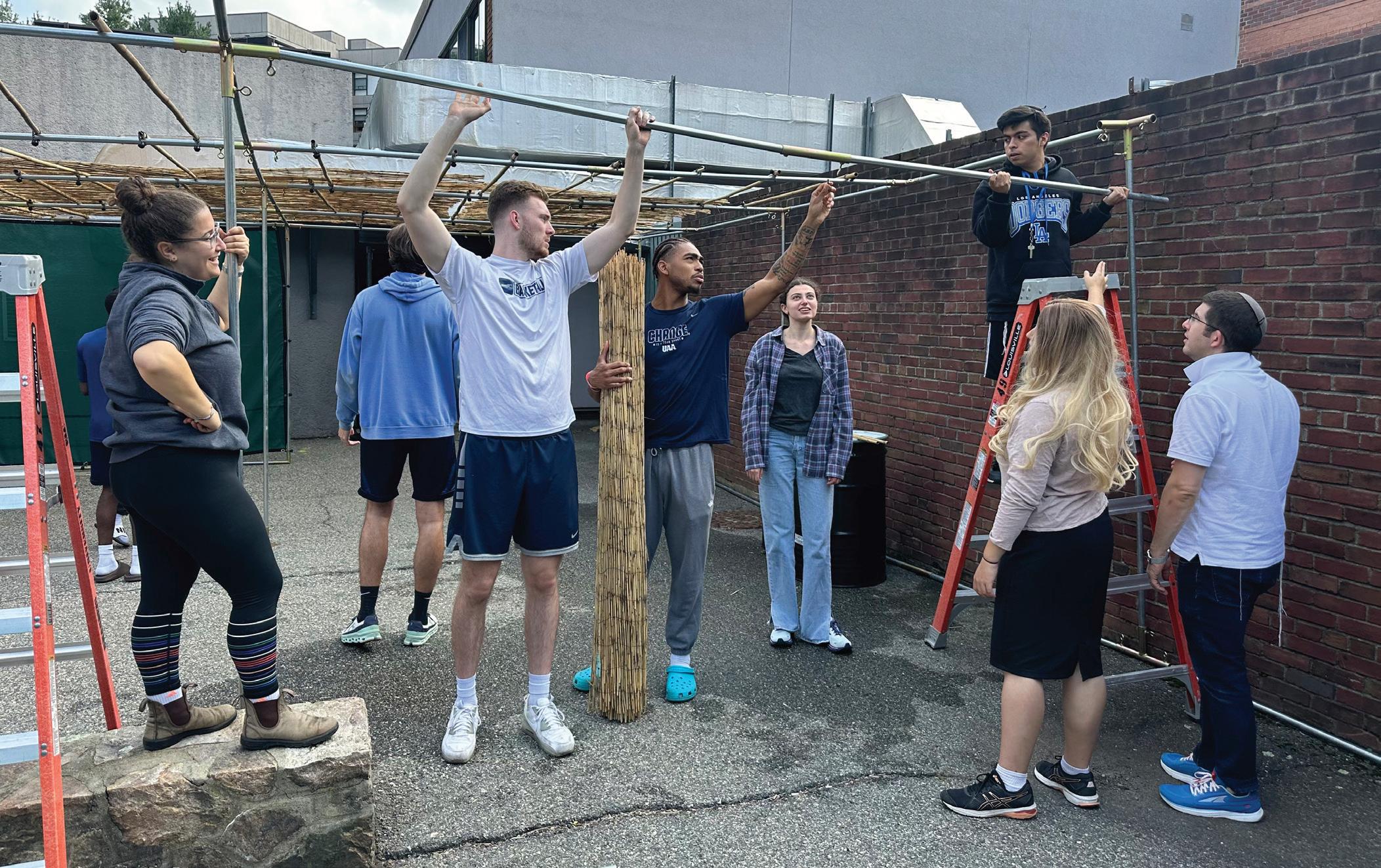
MEDICAL EMERGENCY
give students an opportunity to play pickleball and also to supply the necessary equipment for students that do not already have their own.
The Senate chartered Pickleball Club by acclamation.
Ofri Levisohn ’25 requested that the senate charter Mishelanu, the Israeli cultural club. Levisohn said that Mishelanu provides a place for students to learn about and engage with Israeli culture and the Hebrew language.
The Senate chartered Mishelanu by acclamation.
Leo Zhang ’25 and Sydney Cohen ’25 requested that the Senate charter Students for Environmental Action, which they said will focus on the climate crisis, including environmental racism and environmental justice. In their presentation, Zhang and Cohen showed pictures from SEA’s trip to New York City for the March to End Fossil Fuels last semester.
The Senate chartered SEA by acclamation.
The Senate also confirmed Lexi Lazar ’24 as chief of staff, Sherry Tao ’25 as director of club support, Ifigenia Oxyzolou ’25 as director of sustainability, Kai Kibilko ’25 as director of campus life, Bhakti Parwani ’25 as director of academic affairs, and David Cahn ’26 as director of accessibility. President Noah Risley ’24 appointed each nominee, and the Senate had the responsibility to determine whether or not to confirm them. All of the
MISCELLANEOUS
appointees made a brief speech to the Senate, and after each speech the candidate left the room so the senators could vote.
The Senate confirmed all of the E-Board members by acclamation.
During the meeting, Vice President Erica Hwang ’25 asked for senators to run for the position of Executive Senator, a position which only other senators vote for. The executive senator serves as the Senate representative to the executive board and takes notes during senate meetings. Three senators, Chloe Doonan ’26, Matthew Norris ’26, and Samuel Calel ’27, quickly came up with pitches for why they should take the position. The Senate voted anonymously via Slack messages to Hwang, and chose Norris as the executive senator.
Max Feigelson
Sept. 19—There was a medical emergency. Patient refused medical treatment.
Sept.19—The Health Center contacted Public Safety Dispatch on behalf of a party needing medical transport to Newton Wellesley Hospital. The patient was transported to thew hospital via ambulance.
Sept. 20—There was a medical emergency. Patient refused medical assistance.
Sept. 20–There was a medical emergency. Patient refused treatment.
Sept. 21—A patient required medical attention. The patient refused further treatment.
Sept. 21—A party required medical attention. They were transported to a local hospital via ambulance.
BRIEF
Committee updates from the Board of Trustees
University President Ron Liebowitz provided an update from the Sept. 11 and Sept. 12 Board of Trustees meetings to the Brandeis community in a Sept. 27 email.
Liebowitz welcomed David Harris, who served as the Chief Executive Officer of the American Jewish Committee from 1990 to 2022, as a new trustee. Additionally, Brandeis’ new Dean of Arts and Sciences Jeffrey Shoulson and the new Vice President of the Rabb School Cameron Aguilar were both introduced to the Board.
During preliminary meetings, President Liebowitz updated the Board on “strategic” approaches to support and sustain an “excellent undergraduate liberal arts education and a stellar research endeavor.” Additionally, in his email President Liebowitz wrote about speaking with the Board regarding the work of the Task Force on Academic Administrative Structure, Ph.D. and M.A. degree reviews, the class of 2027, Brandeis’ upcoming 75th anniversary, initiatives against antisemitism, and Brandeis’ efforts to strengthen its relationships with other institutions.
The Board accepted recommendations to grant tenure to Profs. Linda Bui (ECON), Faith Smith (AAAS/ENG), Douglas Theobald (BIOCHEM), and Joseph Wardwell (FA).
Board Committees Meeting Highlights:
CORRECTIONS AND CLARIFICATIONS
A news article incorrectly stated that Waltham mayor Jeannete McCarthy beat Jonathan Paz by 9% in the preliminary elections. It was corrected to 18%. (Sept. 19, pg. 3).
A correction published in the Sept. 12 issue of the Justice about an article from Feb. 2011 is incorrect. The correction has been updated to: The original article stated Lauren Grewal ’13 was the founder of SPECTRUM. The founder is truly Jake Crosby ’11.
A Senate Log incorrectly stated that ‘Deis Chess and Running Club were chartered last year when they were probationary. (Oct. 26, 2022, p.g. 2).
The Justice welcomes submissions for errors that warrant correction or clarification. Send an email to editor@thejustice.org.
Sept. 18—Student reported suspicious activity involving an account they recently opened then closed.
Sept. 19—There was a hit and run. An investigation is to follow.
Sept. 21—Safety authorities checked on the well-being of an individual. The individual was cleared.
The Justice did not recieve the Media Log for Sept. 26 Oct. 2 as of press time.
Compiled by Anika Jain
During the Academy Committee meeting, topics in discussion included enrollment trends in undergraduate education, the role of master’s programs at Brandeis, and a report presented by Provost Carol Fierke on tenure and tenure-track faculty hires in 2023-2024
Prior to the Sept. 11 and Sept. 12 board meetings, members of the Diversity, Equity, and Inclusion Committee came together to discuss the goals of the committee. LeManuel “Lee” Bitsóí, vice president of Diversity, Equity, and Inclusion, presented and invited discussion regarding a draft of a DEI professional development survey. Additionally, Liebowitz writes that Bitsóí “shared a draft DEI addendum to the Framework for the Future for discussion [and that Bitsóí] will be moving forward to finalize that document.”An institution-wide “DEI Strategic Plan” is also in the works.
During the Institutional Advancement Committee meeting, Senior Vice President Hannah Peters and Vice President of Development Stephen Rodriguez, presented fundraising results for fiscal year 2023 and discussed both Institutional Advancement’s fiscal year 2024 goals and next steps for the future fundraising campaign. Liebowitz also spoke to the committee about the upcoming 75th anniversary celebration, which will take place between Oct. 13-15.
Members of the Nominating and Governance Committee met before the Sept. 11 and Sept. 12 board meetings and discussed Trustee candidate recruitment.
All Trustees were invited to the Resources Committee meeting, where they discussed fiscal year 2023 operating results
and predicted fiscal year 2024 operating margins. Other pertinent discussions included “strategic planning for near- and long-term capital investment in campus housing, the Science 2A project, and addressing the significant backlog of deferred maintenance across campus buildings.”
The Risk Management and Audit Committee received updates from many entities on the University’s financial statements for fiscal year 2023, “the state of higher education and accounting ... current efforts to improve internal cyber security ... Public Safety ... services now being provided by DPV, Brandeis’ new transportation operator.”
On Sept. 20, the Student Life Committee, which is made up of both committee members and student representatives, focused on campus priorities including housing and dining issues. “Fostering community, technology, sustainability, and safety” were the driving themes in the housing discussion. According to President Liebowitz’s email, updates with respect to the new dining plans, accessibility improvements around campus, and upgrades to the Shapiro Campus Center were also discussed.
The next Board of Trustees meeting is scheduled for Jan. 29-30, 2024.
NEWS The Justice is the independent student newspaper of Brandeis University. The Justice is published every Tuesday of the academic year with the exception of examination and vacation periods. Editor Managing News Features Forum Sports Arts Photos Copy Layout Ads Online editor@thejustice.org managing@thejustice.org news@thejustice.org features@thejustice.org forum@thejustice.org sports@thejustice.org arts@thejustice.org photos@thejustice.org copy@thejustice.org layout@thejustice.org ads@thejustice.org online@thejustice.org The Justice Brandeis University Mailstop 214 P.O. Box 549110 Waltham, MA 02454-9110 Phone: (781) 736-3750 The Managing Editor holds office hours on Mondays from 7:30 to 8:30 p.m. www.thejustice.org Justicethe 2 TUESDAY, OCTOBER 3, 2023 ● NEWS ● THE JUSTICE
SENATE LOG POLICE LOG
RELIGIOUS OBSERVATION: In honor of the weeklong festival, Sukkot, members of Brandeis Hillel and the men’s basketball team worked together to construct a Sukkah near Sherman Dining Hall.
Photo courtesy of EITAN MARKS
Lin Lin Hutchinson
Brandeis professors discuss future of Affirmative Action
■ The Supreme Court’s decision challenges universities to find alternative ways to boost diversity on campus, as well as jeopardizes other civil rights reforms.
By AMANDA CHEN JUSTICE SENIOR STAFF WRITER
On May 19, 1998, a senior at UCLA was arrested with 84 other students for unlawful assembly after occupying Royce Hall to protest Proposition 209, which banned the consideration of race, sex, and ethnicity in public education, employment, and contracting. These protests were called “Days of Defiance,” and it criticized the decline in enrollment of students of color following the passing of Proposition 209.
That senior was Prof. Chad Williams (AAAS), whose personal experiences illustrated the enduring fight for Affirmative Action and against the proposition’s negative effects on diversity in higher education.
On Sept. 21, the African and African American Studies Department and the Heller School for Social Policy and Management held an academic panel to explore the future of Affirmative Action. Maria Madison, the Heller School’s Interim Dean, moderated the discussion between panelists ProfessorWilliams, Assistant Prof. Amber Spry (AAAS) and Prof. Anita Hill (Heller).
On June 29, the Supreme Court outlawed college Affirmative Action programs, overturning decades of precedent. In a 6-3 decision in the SFFA v. Harvard and SFFA v. UNC cases, the majority decided that race cannot be used as a factor in college admissions because it violates the 14th Amendment’s Equal Protection Clause in the U.S. Constitution. The Equal Protection Clause is “the constitutional guarantee that no person or group will be denied the protection under the law that is enjoyed by similar persons or groups. In other words, persons similarly situated must be similarly treated.” The nonprofit organization Students for Fair Admissions, created by Edward Blum, argued that race-conscious admission programs at Harvard University and the University of North Carolina were unconstitutional. According to a Reuters article, Blum’s goal is “to erase racial preferences intended to boost diversity in American life.”
Hill pointed out that the Supreme Court did not acknowledge Asian American plaintiffs in the case. Specifically in Students for Fair Admissions Inc. v. President and Fellows of Harvard College, Students for Fair Admissions argued that Harvard discriminated against Asian American applicants through their personality ratings.
Harvard claims that they rate applicants on five criteria that do not consider race: academics, extracurriculars, athletics, recommendations and personality. According to The Hill, “At trial, Harvard showed that while Asians scored higher than whites on academics and extracurriculars, and similar to whites on recommendations, they scored lower on personality and much lower on athletics.” Comparing applicants with similar academic achievements showed that Asian people always received the lowest personality ratings. When SFFA argued that Harvard discriminated against Asian Americans by giving them lower personality ratings, “Harvard, in response, argued, and the lower courts agreed, that SFFA could not prove that Asians’ low personality ratings were the result of discrimination.”

The fact that discussions on the Supreme Court’s ruling did not pay attention to the concerns brought by Asian Americans
highlights how conservative groups have used Asian Americans to pit minorities against each other. The case implied that the majority of Asian Americans are against Affirmative Action, but polls show mixed data. AAPI Data’s 2020 Asian American voter survey found that 70% of Asian Americans approve of Affirmative Action when it’s defined as programs increasing minorities’ access to higher education. Moreover, 53 percent of Asian Americans supported Affirmative Action, but 76 percent of Asian Americans “overall said they did not think colleges should consider race or ethnicity as a factor in admissions decisions,” according to a 2023 Pew Research Center survey.
Spry hopes that “we will forge collaboration and community over competition.”
Hill echoed similar sentiments: “I have a hope that we can in fact take those shared experiences and shared pains and turn them into shared aspirations.”
Across the U.S., colleges and universities have been deliberating on how to implement new policies to bolster diversity on campus without violating federal law. Making SAT and ACT test scores optional, prioritizing low-income students, decreasing students’ financial burdens, establishing holistic admissions, creating personal essay questions focused on the effects of race on the applicant’s life, and eliminating legacy admissions are all possible solutions. Hill and Spry emphasized that a welcoming environment that fosters full participation in available academic opportunities is essential for cultivating diversity on campuses.
Moreover, increasing the number of pathways to university can also help strengthen inclusion. Percent plans state that a certain percentage of the top students of a high school class are guaranteed admissions to some universities. For example, Texas’ 1997 “Top 10 Percent Plan” automatically admits students in the top decile of their high school class to any statefunded university. There have been some adjustments at individual Texan universities, like the University of Texas at Austin, who changed their guaranteed admission rate from 10% to 6% in 2017 because of an increase in Texan high school graduates and out-of-state applications. California and Florida also have similar plans.
Geographic plans aim at admitting more students from specific geographic locations, and colleges can target areas with high populations of racial minorities. For example, Harvard University promotes admission of residents in “Sparse Country” states, which include rural states like Montana, South Dakota, and West Virginia.
Additionally, increasing outreach to marginalized groups in middle and high school can help connect students to the college admissions process early on and provide more resources to aid their applications.
The consequences of the Supreme Court’s decision on Affirmative Action is far-reaching and could negatively impact Diversity, Equity, and Inclusion offices, history curriculums, and other racial equality reforms, such as protections for minorities in the workplace. Hill talks about the prohibition of DEI offices and jobs, as well as renaming these offices to exclude words like race, diversity, equity, and inclusion, to avoid contravening the Supreme Court’s decision. Florida Gov. Ron DeSantis approved a bill in May that outlawed public colleges and universities from funding DEI programs.
Moreover, Texas Gov. Greg Abbott banned DEI offices and mandatory diversity training for students and employees in June. Both the anti-DEI legislation and the Supreme Court decision are fuelling future efforts to eliminate DEI programs.
Hill connected anti-Affirmative Action and anti-DEI movements to campaigns against the teaching of critical race theory. “Lessons about slavery and Jim Crow are likely to make
The University’s updated COVID-19 regulations
■ The Justice analyzes the changes made to the campus’ COVID-19 policies and why they were implemented.
By RIVER SIMARD JUSTICE STAFF WRITER
Over the course of September, Brandeis students have continued to test positive for COVID-19. Due to COVID-19 being declared endemic this past June, Brandeis’ approach to the virus has changed.
The University is no longer conducting regular testing of all students like they did in the 2021-2022 school year, nor are they close contact tracing like in the 20222023 year, Colleen Collins, medical director of the Brandeis Health Center, told the Justice in a Sept. 20 interview. Instead, the health center is encouraging students to test themselves when necessary. These tests are often conducted through home antigen tests or taking PCR tests off-campus. If students test positive, they should report to the school through the student patient portal. Students seeking antigen testing can find tests through delivery platforms such as Uber Eats or Capsule, a delivery app targeted at pharmaceutical needs. Additionally, the U.S. Postal Service has once again started offering four free tests per household. However, if students are feeling unwell but are consistently testing negative, the Health Center may conduct confirmatory testing, which is when a PCR test is used to help identify
the cause of the symptoms rather than conduct a test on an asymptomatic student to confirm they don’t have COVID-19.
Previously, the University was able to conduct contact tracing through a contract with the Broad Institute, a company that processed COVID-19 tests, but as COVID-19 became less dangerous due to increased vaccinations, the Broad Institute “winded down” their COVID-19 testing program in June.
In part due to the end of trace testing, the University is no longer creating dashboards that summarize COVID-19 data. Instead, students can find information related to the number of positive COVID-19 cases in Waltham through the Massachusetts government website.
Waltham is included in wastewater testing, a national program where COVID-19 trends can be tracked by examining levels found in community waste. At the time of publication, the levels were not available when viewing COVID-19 trends. Collins declined to provide exact numbers for the number of students who had tested positive this month, but did clarify that the small uptick was not prevalent and was in the 1-2% range for all students. She explained that other academic institutions such as Boston College are no longer collecting data because it can be misleading. This data can be misleading because some students may be ending their two-week period of infection while others may be starting their infection periods, which can misconstrue the actual number of infected students at any given time.
Some students have already started to
white children feel guilty,” Hill said, and this belief drives legislation against diverse school curriculums. She mentions an Oklahoma bill, H.B. 1775, that “unconstitutionally restricts discussions about race and gender in K-12 public schools and higher education.”
“The only way that you can make sense of the Supreme Court decision is through a willful distortion of history,” Williams added. He criticizes the U.S.’ inability to address its history of pervasive racism and compensate for intergenerational inequality.
All the panelists were concerned that the Supreme Court ruling would incite backlash against companies’ hiring practices that consider race. For example, a section of the federal program, the Small Business Administration’s 8(a) Business Development program, was deemed unconstitutional by a federal judge in July. The program was designed to increase marginalized groups’ access to government contracts, and after the ruling, being a racial minority was no longer enough to automatically qualify as socially disadvantaged per the program’s guidelines.
The panelists touched on the roles that power and dispossession play in discussions on Affirmative Action. “When we talk about the issue of Affirmative Action, or any political issue for that matter, we need to ground our discussions in an analysis of power,” Spry said. Politics revolves around who gets what, when and how. Acquiring and maintaining power is connected to education because prestigious degrees help people obtain quality jobs, move up the socioeconomic ladder, and transfer wealth to the next generation. The fight against Affirmative Action programs highlights fears of losing power that are rooted in the racist belief that one race is better than the others. Hill pointed out that these fears have a historical basis in settler colonialism, Manifest Destiny, and more.
Spry emphasized that a zero sum view of success is the only perspective presented to us and argues there are alternative mindsets, such as “Shifting our orientation toward power to be one that’s not additive, but rather one that is multiplicative.” Spry used respondents’ reactions to welfare on surveys as an analogy to conflicting views on Affirmative Action. When scholars survey people and ask them about their attitudes toward welfare, Spry stated that the response was overwhelmingly negative. However, if the question is rephrased and respondents are asked how they feel about giving to the poor, people are much more willing to help others.
Anti-Affirmative Action advocates’ appropriation of the same language that the Civil Rights Movement used also came up in the discussion. Spry stated that it is not a coincidence that the group Edward Blum partnered with, Students for Fair Admissions, has a very similar name to the Student Coalition for Fair Admissions, a group of Asian American students and partners pushing for Affirmative Action programs in the UC system in the 1980s. “The names of these groups claiming to experience discrimination by Affirmative Action, voter protection policy and economic equity efforts,” Spry said, “are using the very language of equity and inclusion in their titles.”
The discussion ended by prompting the audience to reflect upon the fact that white people are not devoid of race. An audience member asked the panelists how to respond to some common questions white people direct towards Black people about Affirmative Action, such as “Did you get into this university because you’re Black?” Spry suggested reframing the question and asking them, “Well, did you get into this school because you’re white?” Affirmative Action critics that argue the policy discriminates against white people fail to take into account the historical economic, social and political privileges that already favor their admission chances.
notice the differences in the way Brandeis has reacted towards COVID-19, including Izzy Andrus ’24. In September, Andrus tested positive for COVID-19 while on a trip with her family to New York. Upon returning to campus, she isolated herself in her single dorm in Ziv Quad for one day before her other roommates began testing positive for COVID-19 as well.
Andrus had previously tested positive twice during her sophomore year, the first time through results from Brandeis’ trace testing program. Despite living in a single dorm in Rosenthal Quad at the time, she was required to temporarily move into COVID-19 housing at 567 South Street. “It was just so much more of a big deal.” Andrus said in a Sept. 28 interview with the Justice. “It was Brandeis who contacted my professors, and Brandeis had a much bigger role in my COVID process.” After her most recent positive case of COVID-19, she did not contact the Health Center, in part because she didn’t know she was supposed to.
One of the ways that Collins encourages students to stay safe is by continuing to get vaccinated. Currently, more than 98% of the Brandeis community is vaccinated, according to Collins. “I think people have to understand that institutes of higher education are congregate living situations. And it’s like sending your child to daycare, they’re going to come home with a whole host of viruses because that’s the setting that we’re in,” Collins said. She explained that the more students are vaccinated for all diseases, the better the community can stay protected.
THE JUSTICE ● NEWS ● TUESDAY, OCTOBER 3, 2023 3 Write an op-ed for
ELIZABETH LIU/the Justice
OCTOBER 18, 2023
WEDNESDAY
12:00–2:00PM
12:00–12:30PM
RECEPTION WITH LUNCH (IN-PERSON)
12:30–2:00PM
PANEL DISCUSSION (IN-PERSON & LIVESTREAMED)

PANELISTS:
Shai Feldman
Abdel Monem Said Aly
Khalil Shikaki
MODERATOR:
Michal Ben-Josef Hirsch
OPENING REMARKS:
Marilyn Diamond, Gary Samore
Free and open to the public Middle Eastern fare will be served
This event will be in person and livestreamed. Registration is required for virtual attendance.
LOCATION:
Rapaporte Treasure Hall, Goldfarb Library, Brandeis University
ELECTION: Updates on the mayoral race
Paz told the Justice in a Sept. 28 interview that, if elected, his first act would be to set up a timeline for a potential redevelopment of the city’s master plan, which would set the long-term goals of Waltham; this would address the “root of the problems,” in Paz’s view and put the city on track for long term growth and success. Additionally, he said he would “absolutely” change the relationship between the city of Waltham and Brandeis University, with the goal of better aligning the agenda of the two institutions. He highlighted traffic issues, in light of recent pedestrian accidents, as areas of potential cooperation.
Paz would not commit to a mayoral term limit, despite critiquing McCarthy on the length of her time in office; however, he stated he “wouldn’t run for a sixth term.”
State Senator James B. Eldridge, a Democrat representing nearby Middlesex and Worcester, spoke on Paz’s behalf at the Sept. 28 event. Paz worked as Eldridge’s field director in his 2018 reelection campaign, where they forged a close relationship. Eldridge described Paz as truly progressive and “forward-thinking.” He also said progressive mayors like Paz would be key allies on issues being debated on Beacon Hill, such as housing insecurity, protecting the rights of ride-share app drivers, and integrating undocumented immigrants.
PROTEST: NYC anti-fossil fuel march

CONTINUED FROM 1
Paz is particularly connected to immigration issues. Besides being a Waltham city councilor, Paz works as a policy advocate for the Massachusetts Immigrant & Refugee Advocacy Coalition.
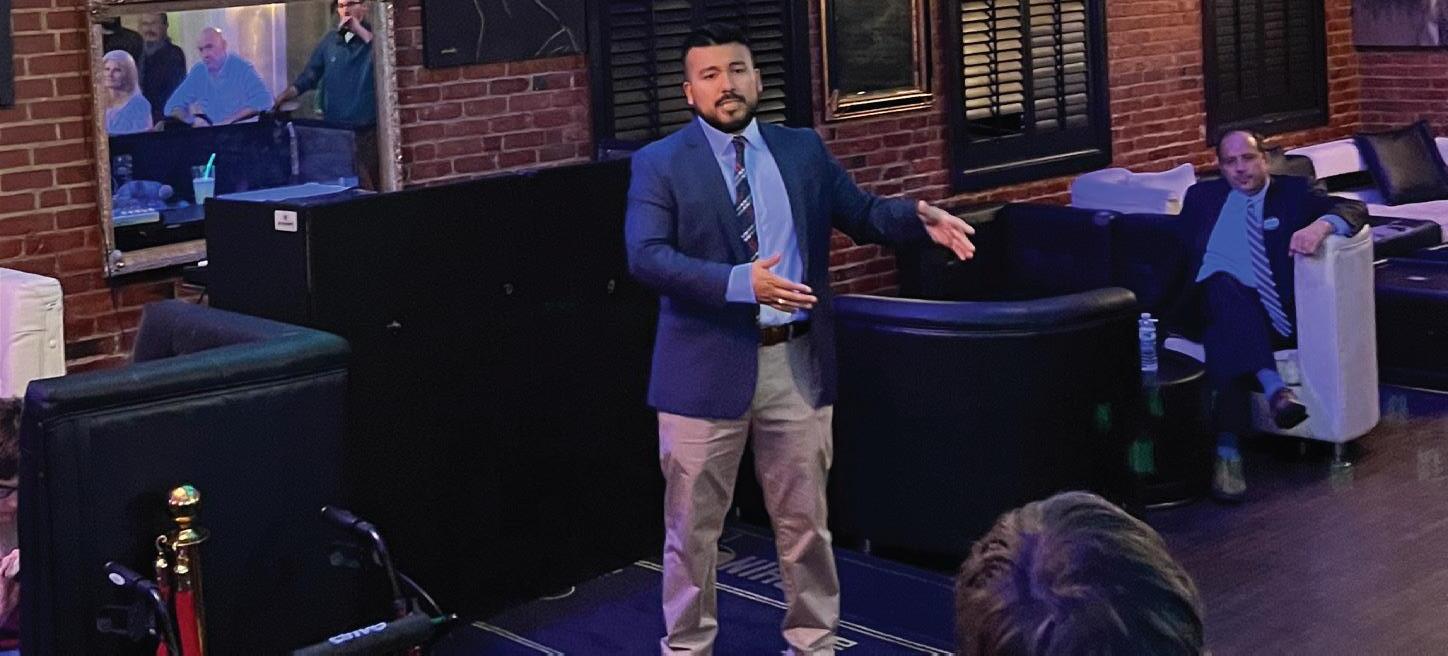
According to his friend and former Massachusetts Immigrant and Refugee Advocacy Coalition colleague Marcus Mattis, Paz led the behind-the-scenes lobbying push for the recent passage of the Work and Family Mobility Act, which enabled undocumented immigrants in Massachusetts to obtain drivers’ licenses. Last year, the Massachusetts Republican Party chairman Jim Lyons filed a restraining order against Paz and Eldridge for allegedly intimidating and threatening volunteers gathering signatures for a referendum to overturn the Work and Family Mobility Act. A judge declined to issue the order.
Sam Dushay, a politically active Waltham resident who has lived in the city for 2 years, sees the possibility of serious city-wide change on issues such as improving sustainability and keeping Moody Street open to pedestrian traffic permanently with Paz as mayor. Despite the enthusiasm around Paz, Dushay still calls him an “underdog.”
McCarthy did not respond to the Justice’s requests for comment as of press time. Waltham residents new and old will have to choose between Paz’s vision and youth or McCarthy’s long record and experience.
RANKINGS: Reactions to U.S. News list
CONTINUED FROM 1
dent Liebowitz outlined in The Framework For the Future,” he added when asked about the University’s ultimate goals.
Lina Alipbayeva, Ceah Nguyen, and Ansel Zhou, three international first-year students, who had recent experience with college applications, shared their thoughts on Brandeis' dropped ranking in Sept. 20, Sept. 21, and Sept. 24 interviews with the Justice, respectively. They agreed that college ranking is a somewhat important factor for international students when choosing colleges.
“I think not all but most Asians [and international students] care about the rankings,” Zhou, a Chinese international student, who also lived in Japan, explained. “I felt disappointed. I screamed in my dormitory really loud[ly],” Zhou recalled.
“It's not ideal,”Alipbayeva, from Kazakhstan, said. “But it doesn't really matter, as long as the academics are at the same level … as long as I get the education,” she added. “It’s disappointing … but personally I don't really care about rankings that much,” Nguyen, from Vietnam, said.
When deciding on colleges, Alipbayeva considered the location, her intended major, and financial aid packages. She wanted to go to a school on the East Coast, because her brother lives in New York City. She is also interested in studying biophysics, and she heard that Brandeis has a good biological science program. Alipbayeva said that she deemed financial aid to be the most significant factor when making her decision and stated that Brandeis has generous financial aid for international students.
Nguyen also pointed to financial aid as a significant factor that led to her ultimately choosing to go to Brandeis. She also stated that the values that the school advertised — such as social justice and community — was another compelling reason for her opting to go to Brandeis. Nguyen said that her high school college counselor encouraged her to prioritize how compatible the school is with her rather than rankings. “I think that's partly why I don't really care about rankings,” she remarked.
As a student with bipolar disorder and ADHD who also identified themselves as a member of LGBTQIA+ community, Zhou said that inclusivity of the Brandeis community is the reason why they choose the school. They explained that Brandeis has accommodations for students with mental illnesses as opposed to schools in China and Japan, where they came from, which do not always have the same resources available.
Zhou also pointed to the small class sizes and potential for close relationships with professors as two other factors that they consid-
ered when making their decision. Zhou has some friends who attend large public schools such as University of California, Los Angeles and University of California, Berkeley, and Zhou expressed his surprise when they heard those large public schools usually have classes with 200 students at the same time.
Although Zhou recognized that “the ranking is unfair, and the [rankings] do not measure things very equally,” they claimed that the ranking still matters to international students to a certain extent.
“I think all the Americans choosing Chinese schools will think about the rankings, because they cannot get so much information from the internet,” Zhou explained. Therefore, American students who intend to attend Chineses Universities will immediately think of Beijing University or Tsinghua University, which are top-tiered universities in China, according to Zhou. When deciding colleges, “we need some quantitative information for us,” Zhou said, and for them, the quantitative information is primarily based on the ranking which makes the ranking very significant.
The school’s lack of attention to the ranking made Zhou frustrated. They anticipated that if Brandeis continued not focusing on the international body’s needs, reputation, and rankings, “a lot of students will transfer out.”
Despite Nguyen and Alipbayeva’s neutral opinions on the Brandeis' dropped ranking, they believed their parents would pay more attention to the ranking. “My parents think it’s [the ranking] an important factor,” Alipbayeva said.
“My parents also like Brandeis' values, and I don't think they care that much about ranking either, probably more than I do,” Nguyen explained, “but not as much as other Asian parents would.”
Zhou’s parents were supportive of them, whether they transfer or decide to stay at Brandeis. When asked about other Chinese international students’ parents, whose children consist of the majority of international students at Brandeis, Zhou said that the parents are debating. For now, half of the parents are concerned about the ranking while the other half are not, according to Zhou, just as the ambivalent responses among the students.
Brandeis isn’t the only university to experience a drop in ranking; Tufts University also dropped from 32 to 40. While ranking shifts do not necessarily signify a change in quality of the institutions, they reshape the public’s perception and the institutions’ reputation as reflected by the international students’ dependency on the qualitative evidence.
volvement and secure funding. The funding for the bus was supported by the Student Union, the Environmental Studies program, and Samuel Center for Community Partnerships and Civic Transformation.
On Sept. 17, the event kicked off with an Invocation of Spirit at Broadway and 53rd Street, where leaders of various faith groups called upon attendees to take responsibility for the stewardship of nature and to set an intention of transformative justice.
From there, attendees convened for the 1.5mile long march, which began at Broadway and 57th Street and ended at 1st Avenue and 51st Street, in front of the United Nations headquarters.

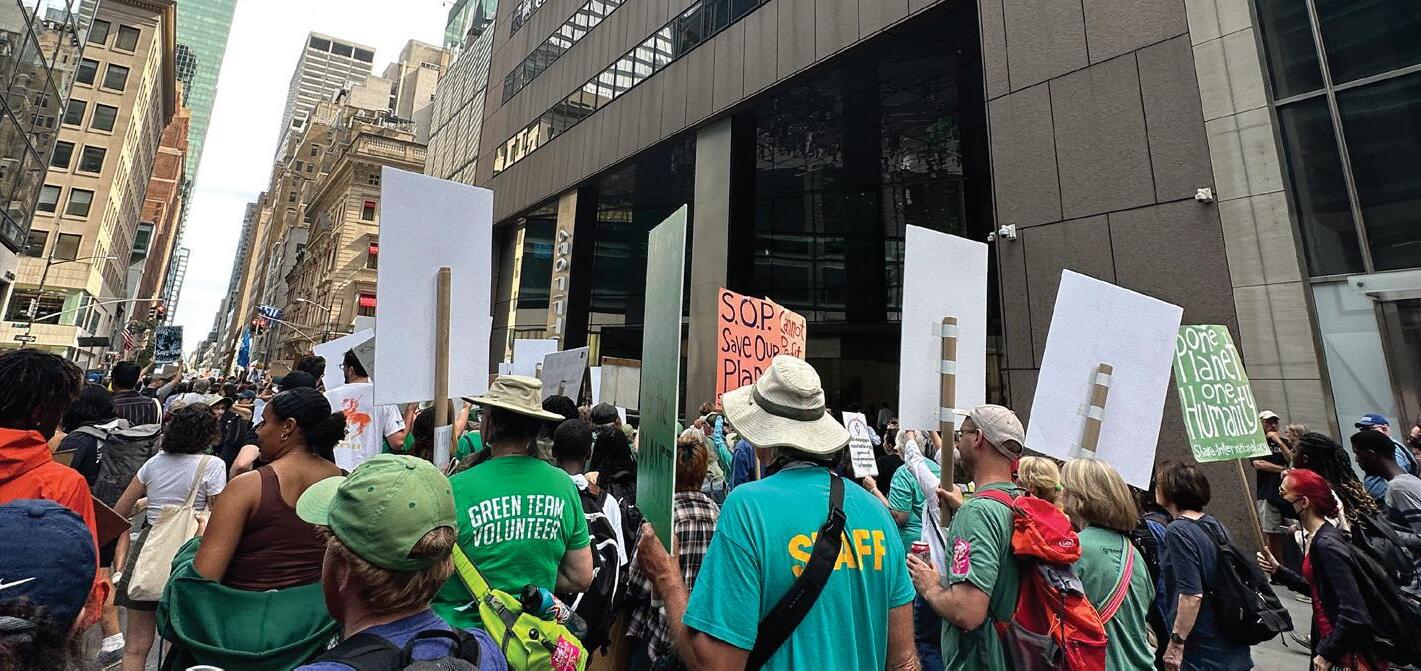

Joining Brandeis at the march were individuals and groups representing a diverse spectrum of backgrounds and perspectives, including but not limited to: nonprofit groups 350 Mass and Extinction Rebellion, students from universities as far as North Carolina and Maine, researchers, animal rights activists, labor unions, and mothers’ groups — groups of mothers whose children are around the same age or who share common interests.
Some groups handed out newspapers and flyers promoting their organization’s events. Others came in costume and toted impressive pieces of art: Members of one group supported what appeared to be a large duct tape model of an oil pipeline stretching across nearly the width of a block.
Brandeis students carrying Prof. Warner’s warming stripes banner captured quite a bit of attention from both attendees and media alike. The banner, spanning approximately 140 feet, depicts global average temperatures from 1880-2021 via colored stripes to provide a powerful visualization of global warming. Blue, white, and cool-toned stripes represent cooler temperatures; yellow, orange, and red stripes represent warmer temperatures. Stripes representing the late 19th and early 20th centuries are depicted in a pale blue, before the banner gradually converges into varying shades of maroon beginning around the mid-20th century.
In an interview with the Justice on Sept.
17, Prof. Warner stated that her original idea was to paint warming stripes along campus walkways for the Year of Climate Action, but decided against it due to environmental concerns. She then convened a small group
of students to sew the banner instead, which has since been on display at Brandeis along the Shapiro Campus Center staircase, in Boston during the Massachusetts Youth Climate Coalition rally in September 2022, and now in NYC, in its largest debut yet.
Despite the long bus ride, the delay to the start of the march that had students waiting under the blazing sun for nearly an hour, and the exhaustion of standing all day, students reflected that the march was an overwhelmingly powerful experience.
In an interview with the Justice on Sept. 26, attendee Caleigh Abbe ’26 reflected on the experience: “It felt surreal to be part of something so big in such a notorious location … actually being there for a cause and a movement that I only usually hear about was really cool.”
The ENVS faculty also reflected upon the importance of Brandeis students’ presence at the march, both in demanding accountability from powerful politicians but also in experiencing collective action firsthand.
“Marching in the street and demanding action together is how we show that we mean it,” Prof. von Mering explained. “In a democracy, politicians are followers, not leaders. What we the people do and say out loud together really matters.”
Prof. Warner emphasized the importance of students witnessing and coming together with climate activists from various walks of life. “Students get a lot out of being here, experiencing this, [and] realizing, ‘Look at how many people there are who care about climate change.’ We hope that some of our students … will go on to become climate activists while they’re in undergrad and when they’re finished [with undergrad].”
While students had a strong showing in the march, Prof. von Mering emphasized that Brandeis is nowhere near being done with the work it must do as an institution to combat the climate crisis.
“First of all: Brandeis must urgently replace Mary Fischer, our director of sustainability, who left a few weeks ago. That is an absolute must,” she stated. “We must divest fully from fossil fuels, hire more faculty with climate expertise, offer more opportunities for students to develop solutions to the problems that cause climate change, make sure we don't accept any research funding from fossil fuel companies, and stop banking with JP Morgan Chase … That's just to get started.”

THE JUSTICE ● NEWS ● TUESDAY, OCTOBER 3, 2023 5
CONTINUED FROM 1
HEDY YANG/the Justice NEW YORK : 75,000 people march 1.5 miles to the UN headquarters to protest the use of fossil fuels.
MESHULAM UNGAR/the Justice
SPEECH : Paz explained to the audience how he plans to disrupt the status quo and increase inclusivity.
Don’t get bitter, just get better.
ON THIS DAY…
In 1936, American track star Jesse Owens won the 100-metergoldmedalinBerlin.
FUN FACT
The first bubble tea came out in the 1980s.
Moody Street’s best bubble tea shop is run by a Brandeis junior
Angel Tea — created, owned, and run by Angel Zhao ‘25, with the support of her family — is a sweet spot smack in the middle of one of Waltham’s busiest streets.


 By CAYENN LANDAU JUSTICE EDITOR
By CAYENN LANDAU JUSTICE EDITOR
Angel Zhao ‘25 has a loaded schedule — she’s currently studying for the MCAT, completing a biology major, working on an art history minor, and learning guitar and keyboard. But on top of her school workload, she’s also the owner and manager of Angel Tea, a beautiful, brightly- lit restaurant and tea shop on Moody and Taylor.
“I’ve always been interested in business,” said Zhao in an Oct. 1 interview with the Justice. As a sophomore, she decided she wanted to find a way to make enough to pay her tuition, both at Brandeis and eventually in medical school. In 2022, an opportunity presented itself: A boba shop she’d frequently visited went up for sale.

Zhao wasn’t a stranger to creating her own recipes. She had successfully participated in the craft market as a first-year at Brandeis, where she’d sold her homemade boba. “People loved it,” she said. “During that, I found people who were very interested in creating stuff — it’s so authentic, and was very inspiring.”
With help from her parents, whom Zhao described as “super supportive,” she went all in on buying the space in the summer of 2022. It wasn’t always an easy process. “We’re first-generation immigrants — we moved to the US from China when I was twelve,” she said. “I’ve always been in charge of reading the bills and translating, and I have to look out for every detail because if I don’t, we could miss something. It’s a hard part of it, but I really enjoy it.”
Zhao said she’s now made enough money from the shop to pay her current tuition. When she’s not studying or in classes, she’s there: going through mail, working on the taxes, handling bills and orders, and other technical issues alongside working at the front desk. “My parents designed the menu,” she said. “It’s all authentic, homemade Chinese food. The drinks I came up with -– I’m a huge boba fan.” Currently, she said, she’s working on a “Sparkling Series,” and perfects the teas by inviting her friends over to do taste tests.
Zhao also said her friends have been instrumental in creating the business. Over the summer of 2022, they helped her paint the interior of the store. “Initially I had a completely different design, but then I realized that it was over budget,” she said. “I’d designed it to be a vibrant environment because I like to create new things, try out new things, and feel excited, and I want the space to echo that.”
Though she carries a sketchbook wherever she goes, Zhao said she didn’t have much time during the year to do as much art as she’d like. Still, her art is an integral part of the shop: One wall is covered with many original black-and-white drawings of the places she’s been on her travels, and she also designs the restaurant’s colorful graphics and logos. “We’re looking for student artists to sell and display their work, too,” Zhao said.
One of Zhao’s favorite parts of running the tea restaurant is the people she’s met along the way. “I’ve been able to form a connection with other businesses, like Game Underground — the businesses here are really supportive of each other. If we get business, it’s more business for everybody … so much of it is about building community.”
Despite all her accomplishments, Zhao is just getting started. “I’m working on the plan for how people can invest in the shop, and I can open new locations in Boston. By the time I start med school, I want to have someone managing it for me — it [the shops] will be my source of income … I always feel so happy when I see people holding Angel Tea cups. My vision is to see people in Boston holding the cups, too.”

VERBATIM | MONIQUE HEART
just
6 TUESDAY, OCTOBER 3, 2023 ● FEATURES ● THE JUSTICE
features
Design: ANNA MARTIN/the Justice
Photo courtesy of ANGEL ZHAO FAMILY OPERATED: Angel Zhao and her mom, Amy, take a selfie in the shop kitchen. Photo courtesy of ANGEL ZHAO SHIPMENT: Zhao poses with boxes. Photo courtesy of ANGEL ZHAO CAKE: A sweet dessert. Photo courtesy of ANGEL ZHAO READY TO GO: A
COMMUNAL
EFFORT: Zhao and friends painted the walls of Angel Tea, pictured.
line of boba decorates a countertop. Photo courtesy of ANGEL ZHAO
What’s the deal with college rankings?
Brandeis dropped sixteen places in the U.S. News’ 2024 list of national universities –but does anyone care? More importantly, should they?
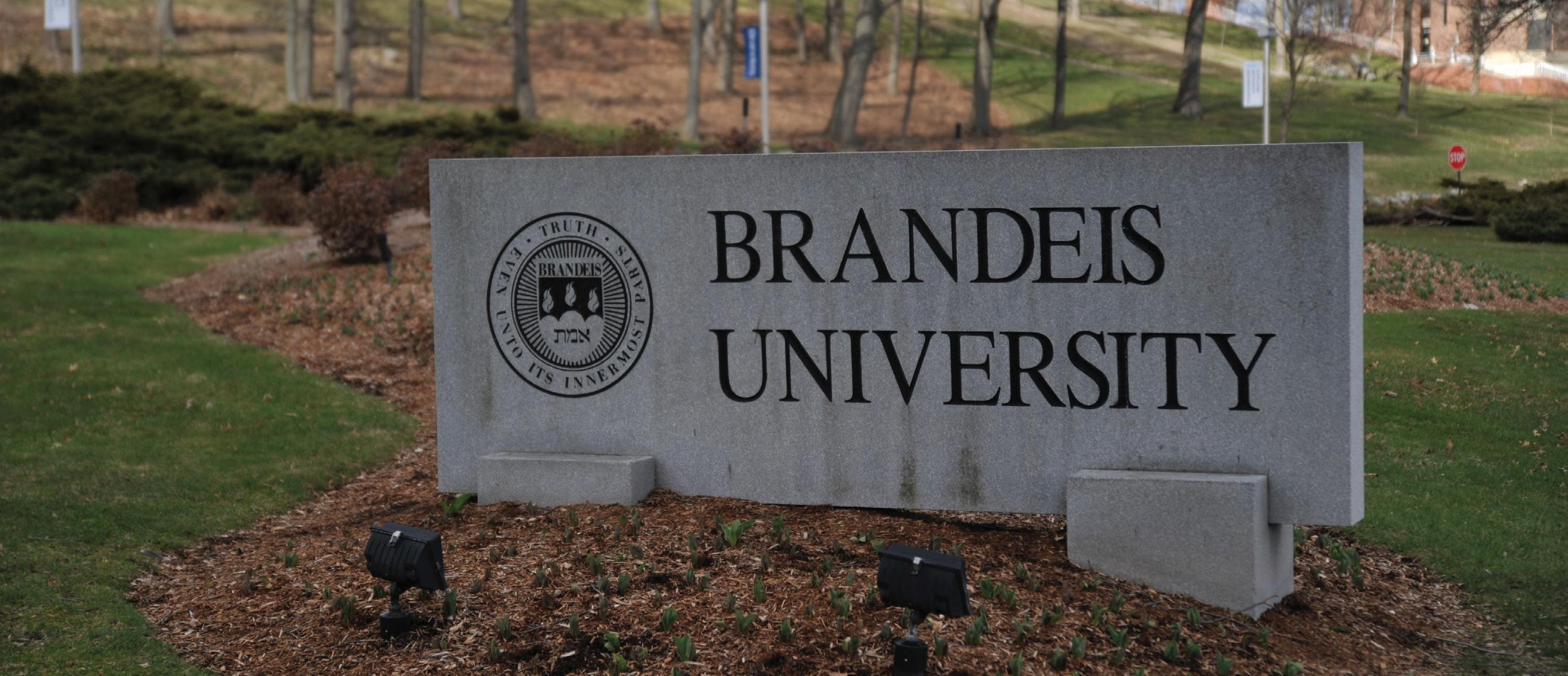 By CAYENN LANDAU AND NATALIE KAHN JUSTICE EDITORS
By CAYENN LANDAU AND NATALIE KAHN JUSTICE EDITORS
Last Monday, University President Ron Liebowitz made an appearance in students’ inboxes, informing them of Brandeis’ substantial drop of sixteen spots in the 2024 U.S. News and World Report’s annual ranking of universities. He cited changes to the ranking methodology, specifically the exclusion of class sizes and the inclusion of recognition in research citations, as reasoning for the plunge from #44 to #60 in the nation. While lightly challenging the syntax of the criteria, stating that “our actual graduation rate is significantly higher than that of most other institutions, the focus on ‘expected graduation rate’ negatively impacts our score…” Liebowitz still narrated a concerted effort by Brandeis to adhere to the standards of the list. “We see other areas of opportunity,” he wrote.“We have been working with faculty to connect their scholarship profiles to Brandeis, as the number of research citations is now an increased part of the methodology…”
This game of push and pull with the U.S. News list is not unique – in recent years, many other institutions have shown simultaneous signs of revolt and submission. In 2022, Yale and Harvard Law Schools withdrew from the list, meaning they elected to stop voluntarily submitting the data that makes up criteria for ranking (though U.S. News vows to rank them anyway, as much of the data is available publicly or through third parties). However, Yale and Harvard continue to participate in the undergraduate ranking, declining to comment to The New York Times exactly why. Even Columbia University, ranked one of the best schools in the world, was disgraced by one of its own faculty in 2022 for doctoring its data to achieve a higher ranking. After this, it fell from the #2 spot to #18, after which it withdrew entirely.
A similar incident at Temple University, as well as Reed College’s early withdrawal in 1995 from the list and subsequent low ranking, indicate the power of the list, and the rewards it promises to those it deems worthy.
But, the relationship between ranker and ranked is more symbiotic than one might assume. For the schools, a high ranking means cultural relevance and even an increase in applications, as shown in a 2014 study by the American Educational Research Association. The schools are clamoring to stay on the list despite guidance counselors and school deans increasingly warning of its flawed methodology, so there’s clearly a draw for them in its stature within the college admissions industry. U.S. News’ continued output of annual rankings since 1983, however, has morphed into something much larger than just a list – it’s pure capital. Universities, hotels, law firms, even hospitals can pay to license the U.S. News “best of” badge in order to promote their inclusion on one of the publication’s lists.
“When you start seeing those kinds of licensing deals from a news publication, it’s evidence that they’re be-
coming increasingly reliant on that as a source of revenue,” Eric Stoller, a marketing executive at Territorium, told The Observer in February.
In 2013, the company saw 20 million viewers a month and made 20 percent of its revenue from online searches for lists, while another 30 percent came from online advertising, according to the Washington Post. College Compass, its $40/month subscription to more detailed college rankings (with access to data about extracurriculars, for example) is another main draw for U.S. News, especially since they suspended their print magazine in 2010 after financial losses. As put by Reed’s former president Colin Diver, the college list is “the jewel to their crown”.
For high school students applying to college, rankings can help to make sense of a vast, unknown new space. Syracuse student Dyana Gales ‘25 said that after getting rejected from her top two schools, she blindly picked the highest ranked school that she had been accepted to, which was Syracuse. “I honestly had no idea what I was doing, so I just followed the list,” she told the Justice in a Sept. 29 interview. The simplicity of a numbered list tends to preclude nuance from the college discussion, though their website claims that “the rankings should be used as a tool for discovering the best fit schools; combined with personal considerations and additional resources.”
However, after students actually get into schools, rankings tend to lose their significance. When Liebowitz’s email went out on the 25th, many students were hearing the news for the first time. “I would probably never have found out about it if he hadn’t sent that,” said David Feit Mann ‘25. The somber tone of the email was even the subject of jokes among students – “why was he acting like somebody died?” said Anya Lefkowitz ‘25.
Students from around the nation on TikTok echoed a sense of apathy about their own schools’ rankings dropping. TikTok user@misguidedghvsts posted on Sept. 19th: “My college dropped 33 places and I think it’s hilarious. I am having the time of my life here.”
Other Brandeis students expressed that the talk of rankings was hollow, and felt like a distraction from real issues on campus. “I was upset about his email because it seems like all administration cares about is our ranking, as opposed to actual struggles and issues students are facing on campus,” said Grace Lassila ‘25. “No one cares what our ranking is when campus is inaccessible.” Meryam Bnyamin ‘24 told the Justice in a joint Oct. 1 interview, “The last few semesters they have been blatantly ignoring students when we voice our concerns. Rather than shifting blame, it would be nice if they could take steps toward actual change for us.”
Despite this, and mounting skepticism of college admissions in general, U.S. News shows no signs of slow-
ing down. In fact, their methodological overhaul for this year’s list reflects a renewed interest in student welfare and relevance to real applicant needs. For years, the publication has articulated their motivations in producing the list the same way: “For most of these students and their families — other than buying a home — attending college is the most consequential investment they will ever make,” said most recently by chief executive Eric Gertler.
The terminology of investment is very purposeful, and also very topical to the changes made for 2024’s list. U.S. News actually demonstrated pointed commitment to modifying their list for low-income students, after decades-long criticism of insular class divisions motivating their decisions. This year, the addition of first-generation student performance and average student loan debt, and the elimination of class size and alumni giving average as factors, are extremely consequential for selective, wealthy private schools like Brandeis.
Additionally, U.S. News elected to reduce the weight of financial resources, referring to the amount of money spent on each student. At first glance, this seems counterintuitive, but their methodology page states that “the reduction in weight recognizes the importance of affordability for prospective students – especially those from lower-income households – and the correlation between a school’s cost and its ability to spend.” A study actually done by U.S. News showed that tuition rates at private universities have jumped 40% in the last twenty years, and in shifting their criteria for 2024, they referenced a 2018 study by the National Center for Education Statistics which found that over 95 percent of respondents rated the cost of attendance to be a “somewhat important” or “very important” factor in their choice of college. The shift to accommodate schools with less resources actually reflects this applicant base more accurately. With the new system in place, schools that traditionally don’t get this kind of recognition made huge strides, with California State University, East Bay jumping 88 places, University of Texas at San Antonio jumping 92 places, and Florida Gulf Coast University jumping 80 places.
While privileged schools like Brandeis, Washington University, Tulane, and Vanderbilt (where actual outrage occurred over the drop) were penalized under the new system, perhaps it reflects a very small step toward equalizing the college process. U.S. News is still a corporation that profits off of its lists, but as long as students are watching, it seems that the publisher sees visibility of different types of schools —not just the Harvards and Princetons —as a priority. In the same Oct. 1 joint interview, Jessica Walsh ‘25 said, “I think these changes to the formula are something [Brandeis] should put more of a focus on for improving rather than attributing the whole thing to class size or citations.”
Design: Anna Martin/the Justice THE JUSTICE ● FEATURES ● TUESDAY, OCTOBER 3, 2023 7
FACE OFF: Antuan Castro del Rio (right), a local activist, confronts members of NSC-131.
Justice File Photo
Isabel Roseth, Editor in Chief Smiley Huynh, Managing Editor
Leah Breakstone, Dalya Koller, Lauryn Williams, Deputy Editors
Asking for a friend
If you are interested in submitting advice for the upcoming column, follow our Instagram: @thejusticenewspaper.
Q:How can first-year students feel confident in classes and on campus if they are feeling out of their depth?
A:“Go meet one-on-one with your professors, during their office hours, or by making an appointment, and share these questions and concerns with the professors. Most professors will be very receptive, and through conversation, you can learn more about what the professors are expecting in the class, how you are doing, and what more you can work on to get the most out of the class. Do reach out! That’s what we’re here for.”
— Prof. Sarah Lamb (WGS)
“It’s helpful to remember that most of us feel this way at one point or another — no matter how well we’re actually doing. Try not to compare yourself to others — and instead focus on how much you are learning and growing as the semester progresses.”
— Leah Berkenwald Health and Wellness Promotion


“It is extremely normal to feel this way in college because you are stepping into the unknown and finding out what you enjoy while being surrounded by others doing the same thing. Assessing your performance as a college student is a subjective process, but there are some indicators that can help boost your confidence.

First, are you being honest and proactive with yourself? Every student faces some challenge in college at one point, but it is how you respond that makes the difference.
Second, how do you feel about your time management while at school? Do you spend hours mindlessly scrolling on TikTok when you should be doing your paper due the next day, or do you timeblock your schedule so you can enjoy activities outside of academics as well.
Lastly, are you utilizing school resources to help you feel confident in yourself? Whether this be booking an appointment with a study skills Brandeis Undergraduate Group Study tutor, chatting with a Roosevelt Fellow for peer academic support, meeting with your advisor, or taking part in extracurricular activities … your involvement with those around you matter!
Discovering your role in the community not only is a form of prioritizing self-care and wellness, but is key in building that confidence that the 5-year old version of you would look up to one day. Be honest, take initiative, take risks, and don’t be too hard on yourself … we are all learning!”
— Isabella Doulas ’24 Roosevelt Fellow, Bridge to Wellness Peer Health Educator
EDITORIALS
Campus dining is undercooked, but on the right track
Dining is an important part of campus life and discourse and has undergone many changes with the start of the year. One of the biggest updates was the switch from Starship to Grubhub as Brandeis’ main food order and delivery app, in addition to the new “All Access” meal plan. As with any new system, there is always room for improvement, and this editorial board would like to provide some suggestions regarding the new dining experiences.
First and foremost, the prices of the meal plans were raised substantially this year, something which many students are upset about — and for good reason. For all the higher prices, students now receive fewer points per semester than before. The “All Access” meal plan sounds good in theory, but in execution, students feel like they are paying more for a worse dining
Some students turn to alternatives to the Usdan and Sherman dining halls due to how busy they can get during meal times. This has made online ordering through Grubhub a popular alternative. The ability to order food ahead of time to pick up later, and the option to have your food brought to you with food delivery robots, are both
However, some students have found that the Grubhub app occasionally cancels their delivery orders and inaccurately estimates the wait times for picking up orders. If these few bugs can be resolved, then the online ordering process will go much smoother for students relying on ordering through the app for their meals.



The long-standing failure to fully accommodate students with allergies also continues to persist. For students who need specific alterations to their order, such as holding condiments due to allergies, they no longer have the option on the app to write in their changes for the items they order. Allergen information listed at the dining halls is not accurate or specific enough, and overall options for students with allergies, such as gluten allergies, remain limited.
Additionally, for students who can only eat at AllGood, due to cross-contamination concerns, there are even more constraints on what they can eat. Even students with access to the gluten-free pantry cannot use it for weekend meals, since Usadan’s dining hall closes at 2:30 on Fridays, leaving students to fend for themselves.
Other alternatives to the dining halls also include the meal exchange menus at select places such as Einstein Bros. Bagels and the Hive. The meal exchange menus at these locations allow students to continue using meal swipes outside of the dining hall and save their points. However, options for meal swipes are still limited, and the prices are not proportional to a meal swipe. According to the University Services website, breakfast at the dining halls costs $12.50, lunch costs $17.25, and dinner costs $18.25. A small drink and a bagel at Einstein Bros. Bagels, which can be exchanged for a meal swipe, add up to anywhere between $6-11. At Starbucks, students can get a slice of cake or a different pastry and a tall drink the smallest sive available.

While this board is content with all the locations accepting meal swipes, this board is also aware that many students have expressed the desire for Dunkin and Wild Blue Sushi to be added to the meal exchange program. Students are willing to use their meal swipes at these two locations but are forced to use their points, as they do not have meal exchange menus yet. These proposed additions of Dunkin’ and Wild Blue Sushi to the meal exchange program would not only benefit the student body but also Brandeis Hospitality, as more students would start to order at these locations.
Students’ experiences with the new system have also been inconsistent. For example, some members of this board have been unable to use meal swipes in person and have had to use the app, while for others, the app doesn’t allow them to order meal exchanges. Members of this board also have a lot of questions regarding the new system’s ripple effects on other parts of dining. Lines at the dining halls during peak hours lead out the doors and once bustling options like the Hoot seem relatively empty.
Members of this board have also struggled to receive a clear explanation of how the system works from Brandeis Hospitality. The system has been adequate in some ways, but it is worth revisiting and updating in order to make it more studentfriendly. These are simply suggestions to improve the dining experience for students; and this board recognizes that the current meal system is an improvement from previous years. However, we hope these persisting issues will be addressed.
Established 1949 8 TUESDAY, OCTOBER 3, 2023 ● FORUM ● THE JUSTICE Justicethe
Brandeis University
ELIZABETH LIU/the Justice ELIZA BIER/the Justice
The devil’s advocate: Debating the abolition of the filibuster
By JACK GRANAHAN and STEPHEN GAUGHAN JUSTICE CONTRIBUTING WRITERS
Context: By the end of the 117th Congress, a new high of 21 members of the U.S. Senate’s Democratic Caucus had voiced support for abolishing the Chamber’s unlimited debate rule, otherwise known as the “filibuster.” Established in 1806, the rule was meant to eliminate subversions of Senate debate, while ultimately allowing any member of the Senate to delay a vote by continuing to speak for as long as possible. Currently, the rule enables any senator to hold up most Senate votes unless 60 members vote to advance invoking “cloture” without need for actual deliberation on the floor.
Since the inauguration of President Joe Biden, various proposals on filibuster reform, and even abolition, have been publicly discussed. Here, Granahan and Gaughan will argue the benefits of abolishing and maintaining the current filibuster, without delving into discussions of how it might be otherwise reformed. Both writers generally hold the views they represent.
For (Granahan):
On Aug. 29, 1957, Sen. Strom Thurmond (D-SC) stopped speaking after over 24 hours of doing so, and thus, the longest singleperson filibuster in American history drew to a close.
Thurmond’s filibuster — which saw him read the election laws of every single state, eat small pieces of hamburger meat, and relieve himself into a bucket in the Senate cloakroom — was his attempt to block the Civil Rights Act of 1957, a crucial piece of legislation that would end the disenfranchisement of African-American voters.
As a sufficient number of votes for cloture were not present, Thurmond was free to block the act’s passage for as long as he could keep speaking.
Thurmond’s filibuster occurred in an era when the filibuster was a longshot, almost comical method of political maneuvering; after all, one man motivated purely by racism can only piss in a bucket for so long while hungry and sleep-deprived.

Today, however, one no longer needs to follow Thurmond’s lead to throw a wrench into Senate procedure. Once a way of exploiting a loophole in the Senate’s rules, the filibuster has since been codified into these rules.
A perpetual speaker is no longer required to carry out a filibuster; all that is required is the refusal of 41 of the 100 members of the Senate to vote for cloture. No thanks to the filibuster, a minority of senators can subvert the will of the majority.
To see the impact of requiring supermajorities to pass simple legislation, one must look no further than the first governing document of the United States: the Articles of Confederation.
Under the ill-fated Articles, Congress — which then consisted of representatives voting on behalf of each of the 13 states — was prohibited from undertaking any actions, including appropriating funds or electing an executive, “unless nine states
assent[ed] to the same.”


In combination with the handicapping of Congress’s abilities by the Articles, the requirement for a supermajority of 9 out of 13 states to agree to do anything nearly led to the end of the United States before it even began.
The filibuster was used in the 1940s to block three bills which would have prohibited the anti-democratic practice of poll tax, which would be used to disenfranchise low-income voters for another two decades. The Civil Rights Act of 1964, which banned discrimination in public accommodations based on race, color, religion, sex, and national origin, was nearly doomed by a filibuster led by Senator Robert Byrd (DWV).
And although the Emmett Till Antilynching Act did not fall victim to the filibuster prior to its 2022 passage, the same cannot be said about the Dyer Antilynching Bill, which was killed by a Southern-led filibuster in 1922. In the century following this filibuster, hundreds of people would be murdered in overwhelmingly raciallymotivated lynchings.
In the 22nd Federalist Paper, Alexander Hamilton lamented the requirement of supermajorities to pass legislation as laid out in the Articles of Confederation, on the grounds that “its operation contradicts the fundamental maxim of republican government, which requires that the sense of the majority should prevail.”
The filibuster has followed Hamilton’s description of the ramifications of supermajorities with a worrisome accuracy.
The existence of a system that allows the will of a majority of democratically-elected senators to be upended by the minority is a repugnant stain on the world’s strongest and oldest enduring political system derived from the consent of the governed. According to an April 2021 survey, 57% of Americans support either abolishing or reforming the filibuster. That is more of a majority than the 41% of senators required to block the passage of a bill will ever be.
Against (Gaughan):
It takes one law to kill a republic. Perhaps this may seem an exaggeration, but in the modern world, it happens more often than you might think. Never lost in the pages of any Republican’s history book is the Latin phrase “Senatus Consultum Ultimum,” or, the final Senate counsel. The SCU signaled support for the Republican consuls, among others, to violate restrictions and even laws in the name of safety. It’s a dangerous concept the post-Enlightenment world has yet to shake.
Following an attempted coup against his regime in 2017, Turkish Prime Minister — now President — Erdogan narrowly shoved through a national referendum overhauling his country’s governance system and enabling him to partially rule by decree. Omitting his previous governments, Hungarian Prime Minester Viktor Orban has, over the last 3 years, utilized his parliamentary majority to seize similar decretal powers multiple times.
In Israel today, the government of PM Netanyahu has advocated a sweeping judicial overhaul which would vest near full power in the country’s parliament, in which his coalition wields a 64-seat majority — approximately 53%.
Historically, tyrants and their henchmen have denounced, with some validity, the mob-rule nature of blanket democracy — lest it be forgotten that in Democratic Athens, by majority vote of his 500 jurors, Socrates was sentenced to die. It would be an overstatement to assert that eliminating this legislative tool would trigger the imminent end of our republic.
Many of the Senate’s left-leaning voices have declared the filibuster’s end necessary for advancing voting, reproductive, and LGBTQIA+ rights. But they should look before they leap. Before the Supreme Court’s Dobbs v. Jackson Women’s Health Organization ruling that overturned Roe v. Wade, two of America’s most wellestablished reproductive rights advocacy
groups, Planned Parenthood and NARAL, notably removed themselves from the filibuster fight altogether, recognizing that with or without the 60-vote rule, threats would remain. Perhaps, in one year of full control, Democrats could push a sweeping ticket of reforms on all the aforementioned subjects. But when inevitably the pendulum should swing right, they’d have to watch their achievements go up in flames.
Democrats know that without entrenchment, strides toward liberal dreams could easily become sprints from conservative-induced nightmares.
Various Republican presidential candidates have advocated policies from abortion bans to federal campaigns against the LGBTQIA+ community, all the way to wholesale abolitions of Federal departments and agencies that would leave countless Americans jobless. Right now, in a politically gridlocked society, any party winning the support of enough states’ populations to secure 60 votes in the Senate is virtually unthinkable, while the idea that any given radical policy could at some point gain a basic majority, depending on who controls the now near-evenly split chamber, is almost inevitable.
In a consensus-demanding system, the 60vote requirement for the passage of major legislation has propelled achievements — in recent years alone — in improving national infrastructure, enhancing gun safety, working to keep the U.S. technologically competitive with China and enshrining same-sex and religious freedoms in Federal law.
It’s true, from wherever you sit on the aisle, that the filibuster has, and will continue to, hold up policies that are important to you. And that’s why it’s important. Because in a nation of well over 300 million people, we all must agree to disagree on so much.
Holding our legislature to similar standards on points of greater controversy embodies that not by promoting the rule of the minority, but by preventing the rule of the mob.
THE JUSTICE ● FORUM ● TUESDAY, OCTOBER 3, 2023 9
The Justice welcomes letters to the editor responding to published material. Please submit letters through our Web site at www. thejustice.org. Anonymous submissions cannot be accepted. Letters should not exceed 300 words, and may be edited for space, style, grammar, spelling, libel and clarity, and must relate to material published in the Justice. Letters from off-campus sources should include location. The Justice does not print letters to the editor and op-ed submissions that have been submitted to other publications. Op-ed submissions of general interest to the University community — that do not respond explicitly to articles printed in the Justice — are also welcome and should be limited to 800 words. All submissions are due Friday at noon. Write to us The opinions stated in the editorial(s) under the masthead on the opposing page represent the opinion of a majority of the voting members of the editorial board; all other articles, columns, comics and advertisements do not necessarily. The Justice is the independent student newspaper of Brandeis University. Operated, written, produced and published entirely by students, the Justice includes news, features, arts, opinion and sports articles of interest to approximately 3,600 undergraduates, 2,000 graduate students, 565 faculty and 1,300 administrative staff. The Justice is published every Tuesday of the academic year with the exception of examination and vacation periods. Advertising deadlines: All insertion orders and advertising copy must be received by the Justice no later than 5 p.m. on the Thursday preceding the date of publication. All advertising copy is subject to approval of the editor in chief and the managing and advertising editors. Fine Print The Staff For information on joining the Justice, write to editor@ thejustice.org. The opinions expressed on this page are those of each article’s respective author and do not reflect the viewpoint of the Justice. E a Sports: Rani Balakrishna Photos: Eliza Bier P a Forum: Xavier Wilson staff News: Maria Antonio, Amanda Chen*, Grace Doh, Sydney Duncan, Max Feigelson*, Anna Martin, River Simard, Hedy Yang, Lea Zaharoni Features: Zev Carlyle, Jessie Gabel, Meshulam Ungar, Lea Zaharoni Forum: Tasha Epstein, Mirabell Rowland, Lauryn Williams Sports: Josh Gans, Zachary Goldstein, Prateek Kanmadikar, Jackson Wu*, Aki Yamaguchi Arts and Culture: Elijah Chen, Craig Disken, Ethan Gerstman, Megan Liao Copy: Wenli Cai, Solana Jolly, Elizabeth Liu, Ava Privratsky, Sara Samuel, Daniela Zavlun, Nataniela Zavlun, Alyssa Golden Layout: Emily Hou, Hedy Yang Ads: Sophia Stewart Online: Amanda Chen, Sabrina Waddell * denotes a senior staff member. ANNA MARTIN/the Justice
Women’s Soccer vs Carnegie Mellon
By RANI BALAKRISHNA JUSTICE EDITORIAL ASSISTANT
Women’s Soccer was voted #18 in the nation by the United Soccer Coaches for the first time in 2023, sliding into the top 25 ranking with an unbeaten record of 4-03 at the time in Region II. Although the Judges lost to Carnegie Mellon on September 30th, their high ranking bodes well for the rest of the season. Brandeis currently has a 4-1-3 record at the bottom of UAA standings but with a powerful team, their future looks bright against upcoming teams. Although the roster this year has plenty of young faces, the strength of the team has certainly not wavered. Throughout the course of October, the Judges will face the rest of their conference opponents away. However, the Oct. 14th Homecoming game against UChicago will be full of Brandeis school spirit, fans, and alumni, and will hopefully bolster the Judges to finish off a successful season thus far. With a winning percentage of .722, the Brandeis Women’s Soccer team has room to improve but shows lots of promise on the field. High scorers Sydney Lenhart ’24, Tanvi Raju ’27, and Yasla Ngoma ’24 have consistently been finding the back of the net, and with assists from Rachel Watler ’25 and Lacey Mbugua ’27, they will continue to excel. Mark your calendars for Homecoming and come cheer on your Judges!


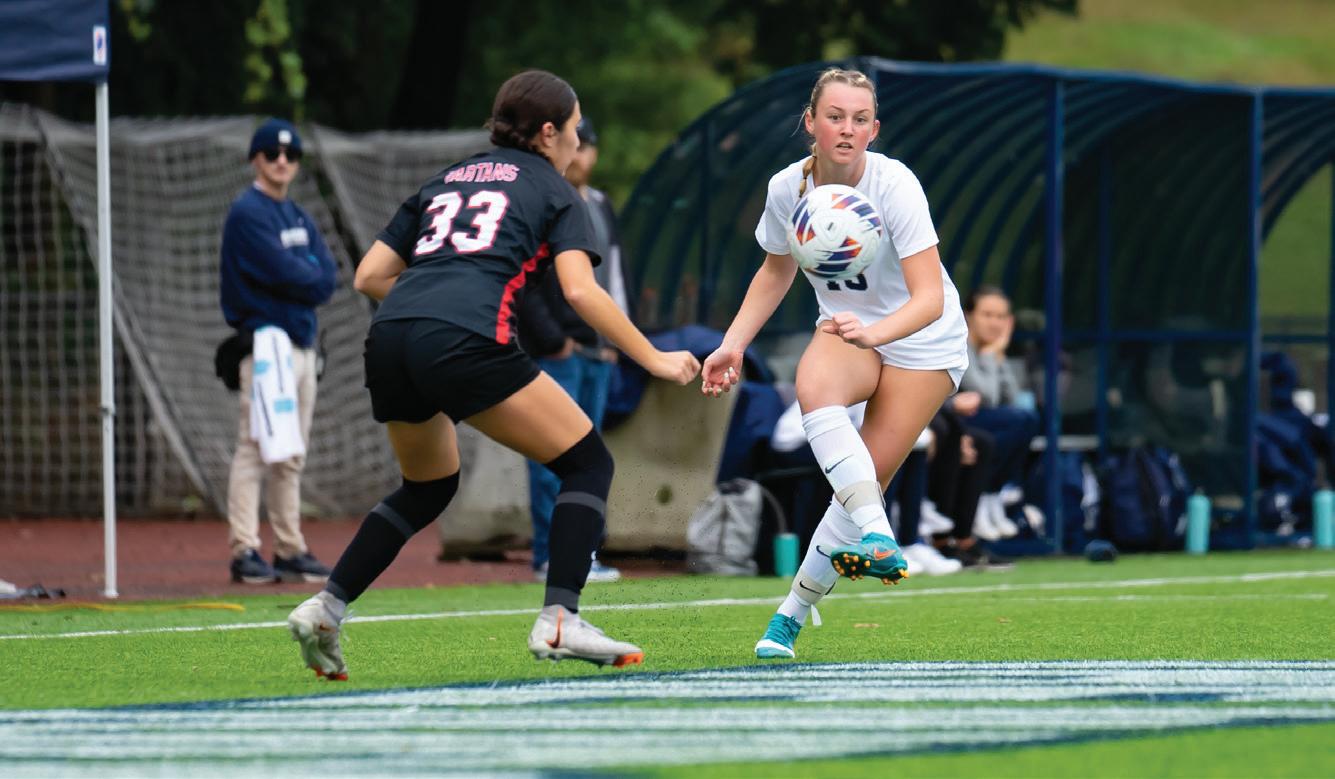

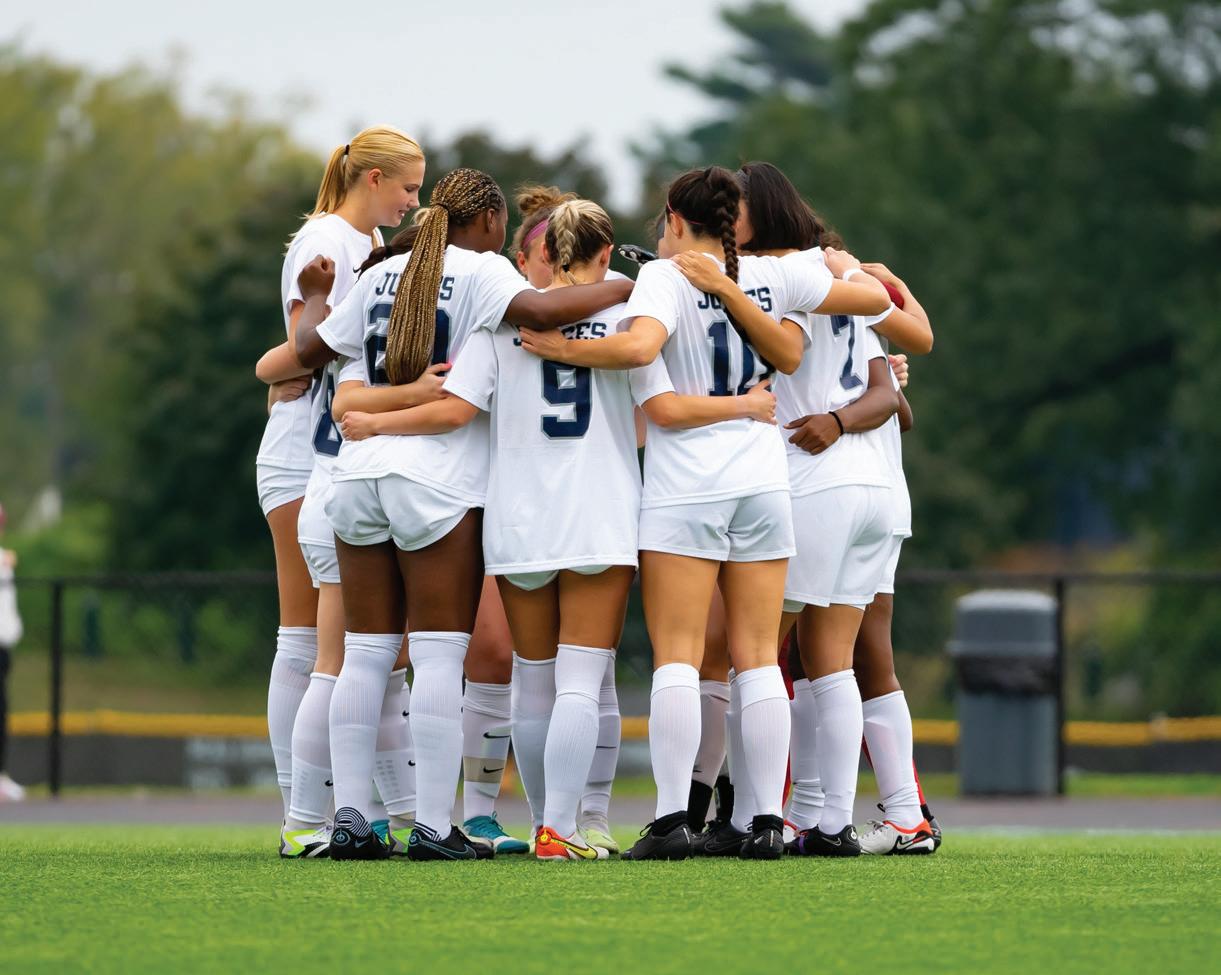



Photos: DANIEL OREN/the Justice. Design: ANNA MARTIN/the Justice. 10 TUESDAY, OCTOBER 3, 2023 ● SPORTS ● THE JUSTICE
STRIKE: Tanvi Raju ’27 works against defenders to get to the goal.
COMPETE: Rachel Watler ’25 works against CMU. BIG MOVES: Sam Kipperman ’26 pushes forward.
HUDDLE UP: The Judges take a moment before taking the field.
LINE UP: The Judges look tough walking on and off the field.
KICKOFF: Abby Kenkelen ‘27 moves the ball down the field.
DEFENSE: Ali Pennella ’27 keeps the ball away from CMU.
FORWARD: Abby Kenkelen ’27 dribbles.
WOMEN’S SOCCER VOLLEYBALL
TEAM STATS UPCOMING GAMES: Assists TEAM STATS Rachel Watler '25 leads the team with 4 assists. Player Assists Rachel Watler 4 Lacey Mbugua 2 UPCOMING GAMES: Wednesday vs. U of Southern Maine Saturday at WashU Goals Assists
Player Goals Sydney Lenhart 5 Tanvi Raju 3 Yasla Ngoma 3 UAA STANDINGS Sydney Lenhart '24 leads the team with 5 goals. W L D W L D Pct. Carnegie 1 0 0 11 0 0 1.00 WashU 1 0 0 7 0 0 1.00 Case 1 0 0 9 0 1 .950 Rochester 0 0 1 7 0 2 .889 Chicago 0 0 1 6 1 3 .750 NYU 0 1 0 7 1 0 .875 JUDGES 0 1 0 5 1 3 .722 Emory 0 1 0 4 2 2 .625 UAA Conf. Overall Sancho Moroto Tobias '24 and Roee Maor '24 both lead the with 2 goals. Player Goals Sancho Moroto Tobias 2 Roee Maor 2 UAA STANDINGS Sancho Moroto Tobias '24 and Aidan Chuang '27 both lead the with 2 assists. Player Assists Sancho Moroto Tobias 2 Aidan Chuang 2 Christian Godinho 1 Juan Vera 1 Wednesday at MIT Saturday at WashU Tuesday at Babson Goals W L W L Pct. Emory 3 0 11 0 1.00 NYU 2 1 15 2 .882 Case 2 1 14 4 .778 Carnegie 2 1 11 4 .733 WashU 2 1 10 5 .667 Chicago 1 2 5 11 .312 Rochester 0 3 12 4 .750 JUDGES 0 3 6 7 .462 UAA Conf. Overall Lara Verstovek ’25 leads the team with 190 kills. Player Kills Lara Verstovek 190 Anna Ertischek 157 Tatiana Wainer 55 Arianna Jackson 49 UAA STANDINGS TEAM STATS Olivia Nirode ’27 leads the team with 124 digs. Player Digs Olivia Nirode 124 Lara Verstovsek 107 Ines Grom-Manseneca 90 Ella Pereira 74 UPCOMING GAMES: Thursday vs. Coast Guard Sunday at UChicago Sunday vs. Carnegie Mellon at UChicago Tuesday vs. Tufts Kills Digs W L D W L D Pct. Case 1 0 0 7 1 1 .833 Emory 1 0 0 7 1 2 .800 Chicago 1 0 0 6 1 2 .778 Carnegie 0 0 1 7 1 2 .800 JUDGES 0 0 1 2 3 3 .438 Rochester 0 1 0 5 1 3 .722 WashU 0 1 0 3 4 1 .438 NYU 0 1 0 1 5 2 .250 UAA Conf. Overall
NBA: Bucks become major contender with new trade
UPCOMING
RECORD BREAKER
champion. However, according to The Athletic, the Blazers showed reluctance to have sincere conversation with Miami, while other NBA teams inquired about potential trade packages for Lillard. As it seemed like the trade was stalled, Bucks’ superstar Giannis Antetokounmpo appeared to be hesitant about extending his contract with the team. “Winning a championship comes first,” Antetokounmpo said in an interview with The New York Times, “I don’t want to be 20 years on the same team and [not] win another championship.” Sensing the urgency to keep Antetokounmpo in Milwaukee, the Bucks started engaging in serious talks with the Blazers in hopes of pairing Lillard up with Antetoukounmpo. Eventually, at the expense of an emotional farewell to Holiday and Allen along with some draft rights compensations, the Milwaukee Bucks rose above and landed Lillard before the NBA preseason.
This three-way trade will likely be beneficial for all parties involved. For the Blazers, getting rid of Lillard–who publicly declared his desire to leave the team–before their training camp starts will not only help with their morale but also establish Henderson, the second-overall pick of the 2023 NBA draft, as the future leader of their squad. The Blazers, on Oct. 1, then traded Holiday, the three-time allNBA defensive team point guard, to the Celtics for center Robert Williams III, guard Malcolm Brogdon, and future first-round picks. The Phoenix Suns finally ended their messy relationship with Ayton, who had been discontent with the team and former head coach Monty Williams, by booking him a ticket to Portland. Ayton, the former number one pick out of the University of Arizona, could play a bigger role offensively in his brand new start with the Blazers.
The Suns also strengthened their roster by adding Nurkic as a potential starting center alongside their new “big three”—Devin Booker, Bradley Beal, and Keven Durant. Johnson and Little are both young players with the
potential to be developed. Allen played an important role off the bench in Milwaukee spacing the floor and shooting efficiently from a distance. His offensive skill set provides depth to the Suns bench going into the new season.

Milwaukee, nonetheless, might be the biggest winner of the trade simply with the arrival of Lillard. Lillard is currently at the peak of his career, averaging a career-high 32.2 points in his final season with the Blazers. The one-two punch of Lillard and Antetokounmpo will be beyond formidable for all NBA teams. Lillard has been known for his deep three-pointers while Giannis’ impact inside the perimeter remains phenomenal, making 65 % of his attempts in the paint. Lillard’s extended range will force his defender to pick him up early as he crosses halfcourt, enabling the Bucks to set high pick-and-rolls with him handling the ball. A strong on-ball screen set by Antetokounmpo for Lillard will force the bigger defender to guard up in an attempt to deter Lillard from shooting, but this will inevitably create a mismatch or an open lane for Antetokounmpo to take off and attack the rim. A pick-and-roll action between these two new teammates will create so many options offensively for the Bucks, challenging every other coach in the NBA to contain the powerful duo.
Landing Lillard has made the Bucks even more competitive in their quest for another NBA championship. After replacing former head coach Mike Budenholzer with Adrian Griffin, the Bucks are ready for their venture in the 2023–24 NBA season. Could anyone stop Lillard and Antetokounmpo? How far could the Celtics go in the increasingly competitive Eastern Conference? The 78th NBA season will soon start on Oct. 24, with the Denver Nuggets hosting the Los Angeles Lakers and a matchup between the Phoenix Suns and the Golden State Warriors. The new iconic duo of Milwaukee will possibly make their first appearance in the Bucks’ season opener at home, where they take on the Philadelphia 76ers on Oct. 26.
of the Bowerman watch list of the most outstanding athletes at the collegiate level to watch for on the international stage, but also because on the international level, the mile, or 1609m, has been replaced by the 1500m. There are only a few other major mile races left in the world despite the mile having a large cultural significance, as the measurement for the mile does not align with the rest of the sports metric system.
 DREAM TEAM: Deandre Ayton was traded to the Portland Trail Blazers as part of the deal.
RECORD BREAKER: Armand “Mondo” Duplantis broke his own world record for the seventh time.
DREAM TEAM: Deandre Ayton was traded to the Portland Trail Blazers as part of the deal.
RECORD BREAKER: Armand “Mondo” Duplantis broke his own world record for the seventh time.
women’s mile U.S. record holder Nikki Hiltz tweeted “Can someone explain to me why at the @nikepreclassic the Bowerman Mile is only an event on the men’s side? If I don’t get a good enough explanation I’m going to start calling it the mojo-dojo mile.” This tweet references the fact that the extremely prestigious race is only held on the men's side, while women race in the 1500m. This is significant not only because it is held in honor of the historical mile races held in the past, or because it shares the name THE JUSTICE ● SPORTS ● TUESDAY, OCTOBER 3, 2023 11
MEN’S SOCCER
MEETS: Saturday, October 14 at Conn. College Invitational
CROSS COUNTRY
RUNNER TIME Willem Goff 26:28.8 Henry Nguyen 26:32.2 Lucas Dia 26:37.8 TJ Carleo 26:42.6 Robert King 27:14.0 RUNNER TIME Zada Forde 19:13.1 Ella Warkentine 19:22.5 Juliette Intrieri 19:31.8 Lizzy Reynolds 19:52.9 Sadie Harrow 19:53.5 TOP FINISHERS (Women’s) Results from the UMass Dartmouth lnvitational on Sept. 17. 5-Kilometer Run 5-Kilometer Run JUDGES BY THE NUMBERS Photo courtesy of CREATIVE COMMONS Photo courtesy of CREATIVE COMMONS ATHLETICS: Diamond League CONTINUED FROM 12 CONTINUED FROM 12 AYTON TO THE BLAZERS, BUCKS GET LILLARD
Data coutesy of THE OFFICIAL SITE OF THE UNIVERSITY ATHLETICS ASSOCIATION and the BRANDEIS ATHLETICS WEBSITE; Images courtesty of CREATIVE COMMONS
TOP FINISHERS (Men’s)
Sports just
Historical Diamond League meet final recap
■ Records were broken by international athletes at the Diamond League Meet in Eugene, Oregon
By SMILEY HUYNH JUSTICE MANAGING EDITOR
The Diamond League had its final meet of 2023 before the upcoming Olympic season, the Prefontaine Classic, in Eugene, Oregon on September 16 and 17. The Diamond League series consists of 15 annual one-day outdoor invitationals throughout Europe, Asia, Africa, and North America. In order to compete in the Diamond League series, an athlete must be invited to compete in some of the 14 meets between May and September of that year. To have the opportunity to compete in the Diamond League's final meet, athletes must score the highest number of points in previous series meets by placing first to eighth to collect points respectively. For the final meet, the top 6 to 10 scorers in each event, depending on the type of event, will then compete for the title of Diamond League Champion.
World Athletics, the international governing body of track and field, reported that this final in Eugene was “the best score in the history of the competition performance ranking.”
Based on the WA scoring table, 99,156 points were scored, the highest ever scored in a one-day meet. This isn’t super surprising, given that there were two world records, 12 national records, and a Diamond League record set at this competition.
Ethiopian distance runner Gudaf Tsegay broke the barely threemonth-old women’s 5km run world record set by Kenyan distance runner Faith Kipyegon in a prior Diamond League meet in Paris by 4.99 seconds to achieve the lightning-fast time of 14:00.21. Armand “Mondo” Duplantis broke his own world record in pole vault, set just seven months prior during the indoor season by a centimeter for his seventh world record. This is after unsuccessfully attempting at three different Diamond League meets, with nine attempts total, to break his world record.
Duplantis took only four jumps at the meet with zero misses. He was in first place by his second vault at 5.82 m with Ernest John Obiena following closely with one miss from this height. However, Duplantis became the last competitor as when they both agreed to move the bar to 6.02 m, Duplantis cleared the bar first attempt, and Obiena missed all three attempts. This left the stage empty for Mondo to attempt the world record for the tenth time, and this time, he succeeded. He said after the event that “The limit is very high, and I hope that I can continue to jump well and keep jumping higher than I did today, but for now I’m not really thinking about
anything except enjoying this moment and enjoying what I just did.”
Embodying the spirit of pole vaulters around the world, he continued, “Everything just [built] up to what I need to be able to break [the] world record.”
Another significant record set at the meet was in the women’s 800m, which had a surprise competitor entrance from the one-time world champion and reigning Olympic champion, US runner Athing Mu. This competitor wasn’t originally listed as competing after a disappointing third Budapest World Athletics Championship three weeks prior. She went on to win with a world-leading time of 1:54.97, which is also a U.S. and Diamond League meet record. The 800m also had some significant national records from second-place finisher Keely Hodgkinson of Britain with a time of 1:55.19, and the third-place finisher Natoya Goule-Toppin of Jamaica with a time of 1:55.96.
In the men’s 800m, there was a switch between the WA Championship three weeks prior between Emmanuel Wanyonyi of Kenya and Marco Arop of Canada, in which Arop won the title. In this meet, Wanyonyi outkicked Arop in the last 100m with a world-leading time and Diamond League meet record of 1:42.80; Arop finished at 1:42.85.
Yaraslava Mahuchikh of Ukraine and Nicola Olyslager of Australia both cleared 2.03 m, with Mahuchikh, the defending Diamond League champion and reigning world champion, only winning based on attempts.
In the men’s discus, Manny Denny of Australia threw a national record of 68.42m in his final throw to win against Kristjan Ceh of Slovenia.
Unsurprisingly, Femka Bol of the Netherlands was crowned the Diamond League champion with a Diamond League record time of 51.98. She finished her season undefeated with 11 straight 400m hurdle wins. She has dominated the season without any significant competition, as her main competitor last year, Sydney McLaughlin-Levrone, switched to only competing in the 400m. She had smashed the world record in the 400m hurdles on three separate occasions, although she had to pull out of the season leading up to the WA championship due to a knee injury. Jakob Ingebrigtsen of Norway from the Ingebrgsten family of track professionals won the prestigious Bowerman mile, a race not often contested internationally, with a time of 3:43.73. He narrowly missed the world record by 0.50 seconds, but with the third-fastest time, he was able to claim the European record. He also won the 3000m, with a time of 7:23.63, he was able to get a photo finish to beat Yomif Kejelcha of Ethiopia. The Diamond League final did not go without detractors. For example,
Damian Lillard joins the Milwaukee Bucks in a three-way trade
■ Seven-time NBA all-star Damian Lillard was traded to Milwaukee, teaming up with former MVP Giannis Antetokounmpo on the Bucks.
By JACKSON WU JUSTICE SENIOR STAFF WRITER
On Sept. 27, the Milwaukee Bucks of the NBA announced that they had acquired Damian Lillard, a seven-time all-star point guard, in a three-way trade. The Portland Trail Blazers, in return for Lillard’s departure, received center Deandre Ayton and forward Toumani Camara from the Phoenix Suns as well as Jrue Holiday, who they later traded to the Boston Celtics, and a couple of draft picks from the Milwaukee Bucks. The Phoenix Suns welcomed center Jusuf Nurkic, shooting guard Keon Johnson, and small forward Nas-

sir Little from Portland and landed shooting guard Grayson Allen from Milwaukee.
Lillard requested a trade out of Portland on July 2, the second day of NBA free agency, after the Blazers renewed forward Jerami Grant’s contract to a five-year, 16 million deal and officially signed rookie Scoot Henderson. Lillard had been the cornerstone of the Blazers franchise for the past 11 years when he averaged 25.2 points per game with a consistent 43.9 field goal percentage. On Dec. 22, 2022, Lillard became the franchise leading scorer of the Trail Blazers, passing legendary swingman Clyde Drexler in the category. This is a rather surprising ending to the Lillard trade saga. The former Portland star demonstrated strong interest in joining the Miami Heat, the 2023 Eastern Conference
BRANDEIS WOMEN'S SOCCER PHOTO STORY
The Brandeis women's soccer team lost to Carnegie Mellon University 0-1 in their seventh game of the year, p. 10.
See ATHLETICS, 11 ☛
Tuesday, October 3, 2023 Page 12 Waltham, Mass.
Photo courtesy of CREATIVE COMMONS READY TO GO: Damian Lillard of the Portland Trail Blazers, will be going to the Milwaukee Bucks NBA
ATHLETICS See NBA, 11 ☛
 Photo: Ceci Xilei Chen/the Justice. Design: Owen Chan/the Justice.
Photo: Ceci Xilei Chen/the Justice. Design: Owen Chan/the Justice.
October 3, 2023 Vol. LXXVI #3
Waltham, Mass.
“Strong Women in Renaissance Italy,” only a train ride away!
By MIKEY TERRENZI CONTRIBUTING WRITER
On Sept. 9, 2023, the Museum of Fine Arts opened an exhibition titled “Strong Women in Renaissance Italy,” which focuses on the life and works of women and craftswomen of 16th and 17th century Italy. The exhibition was curated by Marietta Cambareri, a senior curator of European sculptures and author of the related publication, “Strong Women in Renaissance Italy.”Additionally, she assisted Simona Di Nepi, curator of Judaica at the MFA, in the exhibition. Female artists in history have not been highlighted nearly as much as their male counterparts despite their historical contributions. Cambareri aims to highlight the contribution of artists that history has left out of the narrative. Located in the MFA’s Gallery 184, this exhibition takes the viewer through fine arts and detailed crafts to show the Renaissance through the women of the time. Many artists of the Renaissance are famous for their contributions. Michelangelo, Raphael, Da Vinci, and their contemporaries carved a corner for themselves in the canon of art history, but women like Sofonisba Anguissola have yet to have their time to shine. The exhibition is not only about female artists, but also the lives of women in Italy during the 1500s and 1600s and the art they consumed.
FILM REVIEW
Anguissola is one of the first artists introduced in the gallery. Her work is an oil on parchment: “Self-Portrait,” from 1556. This work is a declaration of her space in the art world. Anguissola paints herself in this small work with a large disc in front of her body. The disc declares her father’s name as the man who encouraged her to pursue her artistic talents, but not just that her own name is painted in Latin on the outer space of the disc, declaring her hand in the creation of the painting. There are also allusions that create a connection between Anguissola and ancient women who painted their own portraits like Iaia of Cyzicus. Her work is truly contemporary to its time and makes an impression on the viewer.
Anguissola, who was present in the Spanish court and a contemporary of Michelangelo Buonarroti, is a master of portraiture, but her work is sadly forgotten to time by the patriarchal erosion of women in history. A later artist, Lavinia Fontana, found artistic success as a woman in 17th century Italy. In the MFA, her piece “Virgin Adoring the Sleeping Christ Child” shows her creative abilities typically associated with the High Renaissance and the early Baroque. The painting is of the Virgin Mary in contemporary dress, protecting and observing the sleeping child, Jesus Christ. This panel is in the shape of a triangle, possibly serving both

a utilitarian purpose as an insert in a larger piece, and as a religious symbol, typically associated with the Trinity. Fontana’s ability as an artist and her experiences as a mother informed this painting as well, showing the Christ Child in a limp and lifeless position on a cradle that resembles the sarcophagi of the time — a reference to her own experience losing many of her eleven children. Fontana was able to achieve notoriety in her time as a skilled painter and artist, being personally invited by Pope Clement VIII to work in Rome. Later, she joined a society of artists and intellectuals. She was as an educated woman in Renaissance Italy and defied the male-dominated perspectives of her contemporaries. Both of these artists’ works can be seen in the MFA as a way to highlight the strength and perseverance of women during the 16th and 17th centuries. Both Cambareri and Di Nepi had the goal of uplifting women from a patriarchal time and sharing with the public their contributions to the canon of artists. This exhibition is open until Jan. 7, 2024, and is admission free with your Brandeis ID. Cambareri and Di Nepi have created a once-in-a-lifetime gallery with a fantastic audio tour that is also accessible to hard-of-hearing and visually impaired individuals with transcripts and descriptions of the pieces. Check it out!
Sanaa Lathan’s ‘On The Come Up’ is ‘Bri-lliant’
By MINA ROWLAND JUSTICE EDITOR
It seems as though most of us spent our summer doing internships, working, or trying to relax before getting back into the groove of all-nighters, exams, and papers.
If you know me, I love to find new films, especially at the intersection of music and poetry. I rewatched several of my favorite films like “Hidden Figures” and some cute Pixar comfort movies, but I enjoyed watching “On the Come Up” the most. I initially read the book “On the Come Up” by Angie Thomas last summer, but I was beyond excited when I heard it was being turned into a film, specifically as Sanaa Lathan’s directorial debut.
As an aspiring director, it is incredibly difficult to find films that are not only directed and created by Black filmmakers, but also balance Black joy and Black pain without focusing solely on trauma.
Angie Thomas is a well-known author in the Black community who gained acclaim in her debut novel “The Hate U Give” which was turned into a film in 2018 starring Amandla Steinberg. While “The Hate U Give,” is so well articulated, “On The Come Up” just brought a fresh perspective and is now one of my top favorite films. It premiered at the Toronto International Film Festival in June 2022 and is now available on Paramount+.
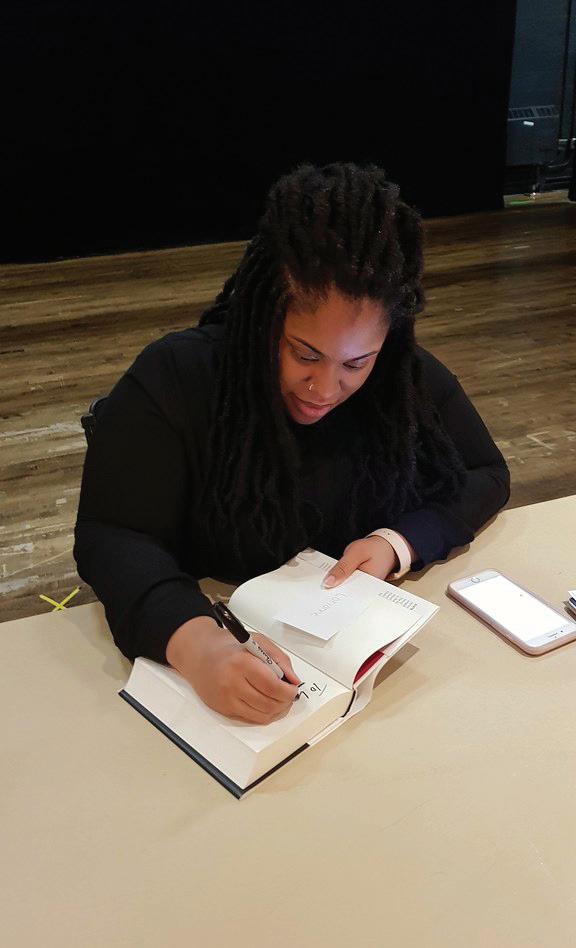
“On The Come Up,” like “The Hate You Give,” takes place in the fictional city of Garden Heights. The film follows the story of a young black girl and looks at the intersection of race and gender within music, as well as the hypersexualization that lends itself to modern rap and hip-hop. The film, however, is more than just an analysis of music but also explores family, brokenness, poverty, and what success means.
In the opening scene, we are introduced to our protagonist, Brianna Jackson, played by Jamila C. Gray, as a teenager who has been through a very emotional time and who finds peace through poetry and rap. It is no secret that she is gifted at rapping, which some might attribute to the fact that
it runs in her family. Her father, Lawrence “Lawless,” was an underground rap legend who was a victim of gang violence before he was able to “make it” in the mainstream hip-hop industry. To honor her father’s legacy, Brianna is consistently participating in a rap, competition which is seen as “the Hunger Games of hip-hop” at her local venue to prove herself as a rapper, especially being a girl.
Brianna has an older brother, who is a modern representation of the “talented tenth,” an educated Black kid who is still struggling. He is the first in his family to have graduated college and he plans to attend medical school, but he sacrifices his dreams of becoming a doctor to help his family when their mother loses her job. Brianna’s mother, Jay, however, is the opposite. An extremely important character, Jay is a recovering drug addict that is clean and constantly navigating her relationship with her children and with Bri in particular. Lathan is the main architect of the story, not only directing the film but also portraying the role of Jay. She creates a beautiful invention of the book and breathes life into the character, humanizing folks of color and folks that struggle with addiction. The climax of the film is really a series of domino-effects from various events. Brianna attends a predominantly white high school called Midtown School of the Arts and is constantly facing microaggressions. Having been one of the few Black students at her high school, her actions tend to be more heavily surveillanced than the other students’, and after selling Skittles and other candy to another student, the school security literally body-slams her to the ground. Her mothers’ instinct [immediately] to stand up for her daughter’s basic human rights was imperative to see, especially with their tension-filled relationship.
In the midst of all this, Bri rises in her rap game, calling herself ‘Lil Law,’ and she ultimately wins one of the rounds against the son of a famous — and wealthy — rapper and music producer called Supreme. Supreme reaches out with an opportunity and while it seems that Bri is “on her come up,”
Supreme is really the antagonist of the film, as he believes that playing into stereotypes and selling one’s soul is the only way to survive in such a cutthroat industry.
Brianna wants to use her passion to create her own message, but the pressure of poverty convinces her to write and record her first song. She falls into the trap believing “you say what you have to say to sell records,” even if that means playing into stereotypes. Initially, the song is a hit, but unfortunately it does not take long until it becomes a site of contention. She directly references the incident at her school, uses violent language, and makes a comment about the gangs in her neighborhood.
Unfortunately, the news and media paint Brianna as a thug, drug-dealer, and terrible student — and it doesn’t stop there. Several white parents are upset about their kids listening to Brianna’s music claiming her song is the reason for racially motivated events rather than a response to them.
Brianna’s life seems to go from bad to worse; her mother struggles with unemployment, and slowly the bills pile up, leading to the water, heat, and lights going out. The film exposes the reality of poverty; and Black people’s inability to fight the cycle; and the way society portrays them as lazy, government dependent, and unmotivated. The nearly two-hour film has a beautiful ending for our protagonist, as we get a chance to see Brianna’s family and friends give her the courage she needs to create her own success without compromising her music.
While the film carries such nuances on aspects of race and identity, I would be remiss not to discuss the gender politics at play when it comes to the rap and hip-hop industry. The rap battles in the film and the song Brianna writes and performs is so beautiful, because in several battles she not only rarely cusses, uses inappropriate language, or sexualizes herself, but she also criticizes others for reinforcing that in their music.
In my humble opinion, Lathans’ first work as a director delivers a strong visual presentation and balances the richness of the story and characters throughout the en-
tire film without feeling too overwhelming. Everything from the music, costume design, lighting and cinematography make the film a powerful tool in telling the story of Brianna Jackson. That story
is one of pain, yes, but also perseverance and ultimately brilliance, because you can’t spell brilliant without ‘Bri.’
THE JUSTICE | ARTS | TUESDAY, JANUARY 31, 2017 Design: MINA ROWLAND/the Justice
EXHIBITION REVIEW
TUESDAY, OCTOBER 3, 2023 I ARTS & CULTURE I THE JUSTICE
14
Photo courtesy of CREATIVE COMMONS
Photo courtesy of CREATIVE COMMONS
AUTHOR: “On The Come Up,” authored by Angie Thomas is the basis of the film.
EXHIBITION: The Boston MFA’s exhibition “Strong Women in the Renaissance examines women painters that were often overlooked
MID-AUTUMN FESTIVAL
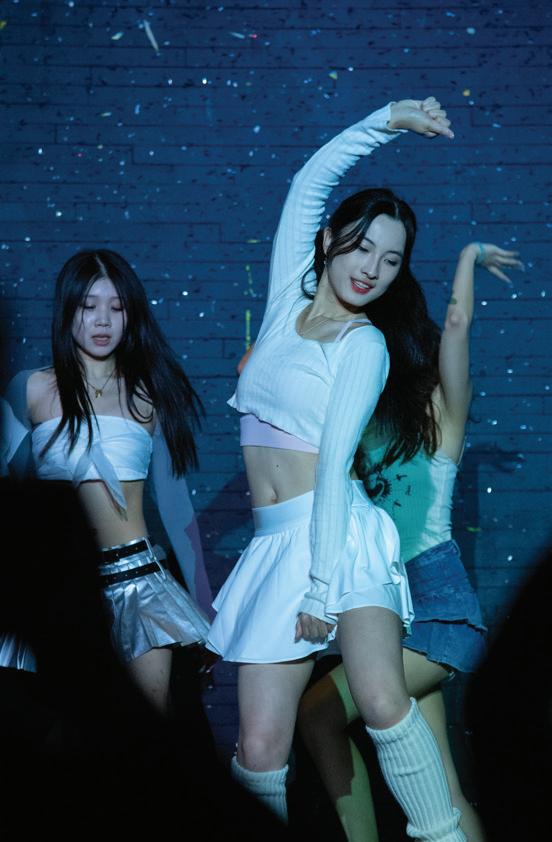

 By ANNA MARTIN JUSTICE EDITOR
By ANNA MARTIN JUSTICE EDITOR




The Brandeis Chinese Culture Connection Club held their “MidAutumn Festival Gala” in Levin Ballroom on Sept. 30. This event celebrates the harvest festival celebrated in Chinese culture also known as the “Mooncake Festival” as it runs through the full moon. BC3’s show consisted of 8 performances including dance performances, singing, and theatre performances. They also served traditional Chinese refreshments including tanghulu, mooncake, and bubble tea.




THE JUSTICE | ARTS | TUESDAY, JANUARY 31, 2017 15
TUESDAY, OCTOBER 3, 2023 I ARTS & CULTURE I THE JUSTICE
Photos: CECI XILEI CHEN AND IVY TRAN/the Justice. Design: ANNA MARTIN/the Justice.
CAMPUS EVENT
By RANI BALAKRISHNA JUSTICE EDITORIAL ASSISTANT
Top 10 dog breeds
I am a big dog person, I love both little dogs and big dogs. Recently, I’ve been really needing some dog cuddles, so enjoy my biased and mildly arbitrary ranking of dog breeds.
STUDENT ART SPOTLIGHT


Mina Rowland is a self-taught illustrator that creates a more diverse landscape within art. She is interested in storytelling through film, animation, and creative writing. If you can’t find her in the Justice office editing her articles, she is probably taking pictures of plants or writing poetry. Her favorite color is yellow.
WEEKLY HOROSCOPES
By TRIONA SUITER CONTRIBUTING WRITER
A change is coming. Perhaps you are in the midst of a change already. Something may have ended or been lost recently. Or you may be stagnating, waiting for something to break you out of an unchanging state. Remember that recovery is not linear. You may need time to regenerate and heal. Regardless, know that you will emerge from your hardship transformed.
You’ve either recently come to a realization of some weakness in your character or have grown frustrated with yourself for lacking a certain ability. Persevere! Proficiency comes with experience. Approaching the obstruction logically and remaining mature will help you overcome it. Work on developing your physical and mental endurance and you will find stability.
Don’t let your ambition overwhelm you. The stakes may be high, but you have everything you need to succeed already inside you. Remain disciplined and reasonable. You have the willpower to achieve great things. It’s important to slow down sometimes and appreciate the journey for itself, not just for how it brings you closer to your goal. There’s no need to rush. You’ll get there.
If you’re struggling to see the positive things in life, try to spend more time with people you care about. This is a good time for you to open up about any anxieties you may be concealing. You are not the only one who is weary, bored, or discontent. Isolating yourself isn’t the answer. Asking for help can be hard, but it’s the best way to find new light.
You may be vacillating between choices right now. Follow your intuition, but don’t let desire outweigh what you know to be right. Indulgence isn’t worth sacrificing your morals. You may not yet have realized what is and isn’t a test. Err on the side of caution in those cases and don’t risk failure needlessly.
You’re approaching personal success! This is a time to take precautions to ensure security in the future. Rely on your family if you need to and allow them to rely on you in return, but don’t sacrifice your personal needs for the needs of others. Things may be going well now, but you should never get complacent. Avoid gambling lest your luck run out.
Always pause to clarify before doing anything that might be a violation of boundaries, be they someone else’s or your own. If you are considering leaving a restrictive situation, attempting to manipulate others involved is likely to backfire. You have the skills and determination to do whatever you need to do. Just make sure you’re doing it for the right reasons.
You carry a high amount of responsibility, but that doesn’t mean that remaining objective in every situation is the wisest choice. Your emotions exist to guide you just as much as your thoughts do. Learning to accept that you cannot always control everything will make you a better leader. Remember to have empathy, both for those around you and for yourself.
Just because you want something doesn’t mean it’s healthy. Take a moment to reflect on your habits and evaluate whether any of them are damaging. Try to be as honest with yourself as possible, especially when you don’t want to be. You are allowed to imagine something without it being a good idea for that thing to come to life.
You naturally have an open heart, and if you have a good reputation it is well-earned. Now is the time to continue honing your skills. Money is not insignificant, but it is not the be-all, endall solution that you are hoping for. If you are seeking something, connection with others will be the way to find it.
You have a lot on your mind right now. You may be dealing with anxiety regarding a loved one. Fear is a natural human response to uncertainty, so don’t be ashamed of being afraid. Acknowledging fear is the best way to overcome it. Meditation could be a possible sanctuary for you. Have faith in yourself and your strength. Hang in there.
You may be facing a challenging moral dilemma. If you’ve lost your bearings on your moral compass, just try to act with the best intentions possible. The right choices will come to you. If there is someone far away that you are missing right now, you should call them; they’re likely missing you too.
1. German Shepherd
2. Golden Retriever
3. Staffordshire Bull Terrier
4. Nova Scotia Duck Tolling Retriever
5. Australian Cattle Dog
6. Australian Shepherd
7. Labrador Retriever
8. Bernese Mountain Dog
9. Chinook
10. Pitador
MINA ROWLAND/the Justice
TUESDAY, OCTOBER 3, 2023 I ARTS & CULTURE I THE JUSTICE
STAFF’S
16
Top Ten
ARIES TAURUS GEMINI
CANCER LEO VIRGO
LIBRA SCORPIO SAGITTARIUS
CAPRICORN AQUARIUS PISCES
Photo courtesey of RANI BALAKRISHNA

 By CAYENN LANDAU
By CAYENN LANDAU















 By CAYENN LANDAU JUSTICE EDITOR
By CAYENN LANDAU JUSTICE EDITOR


 By CAYENN LANDAU AND NATALIE KAHN JUSTICE EDITORS
By CAYENN LANDAU AND NATALIE KAHN JUSTICE EDITORS



















 DREAM TEAM: Deandre Ayton was traded to the Portland Trail Blazers as part of the deal.
RECORD BREAKER: Armand “Mondo” Duplantis broke his own world record for the seventh time.
DREAM TEAM: Deandre Ayton was traded to the Portland Trail Blazers as part of the deal.
RECORD BREAKER: Armand “Mondo” Duplantis broke his own world record for the seventh time.

 Photo: Ceci Xilei Chen/the Justice. Design: Owen Chan/the Justice.
Photo: Ceci Xilei Chen/the Justice. Design: Owen Chan/the Justice.




 By ANNA MARTIN JUSTICE EDITOR
By ANNA MARTIN JUSTICE EDITOR









